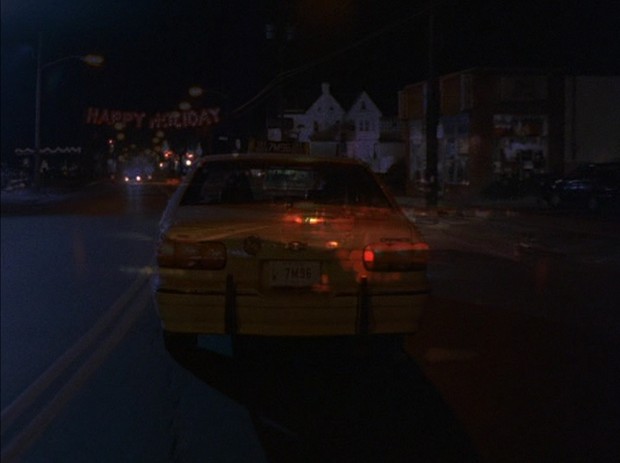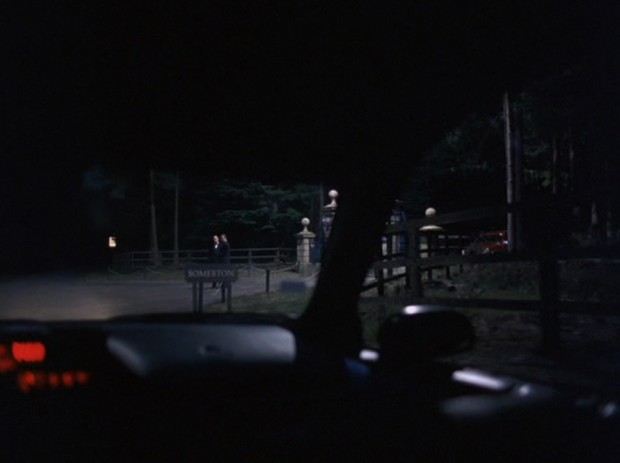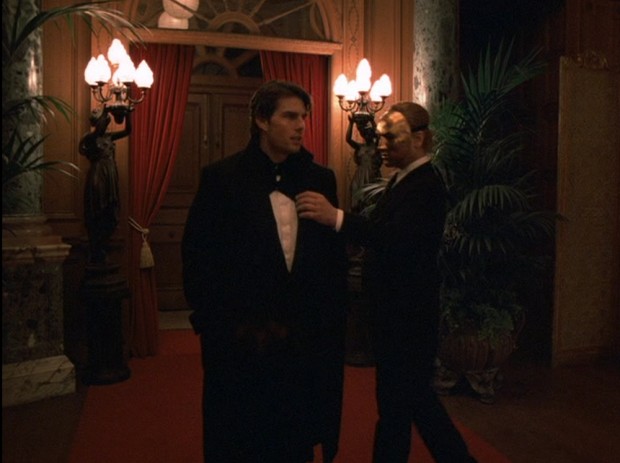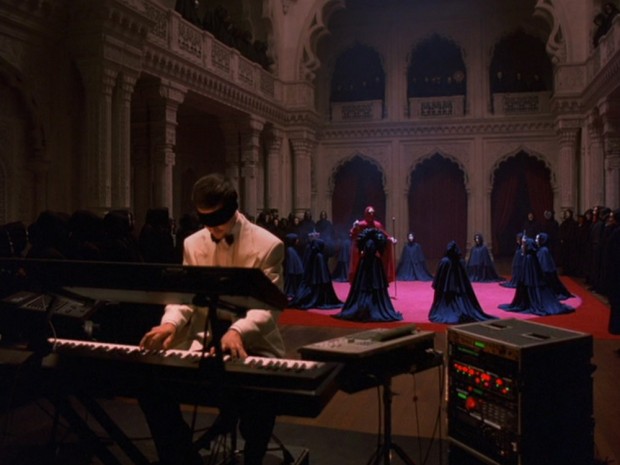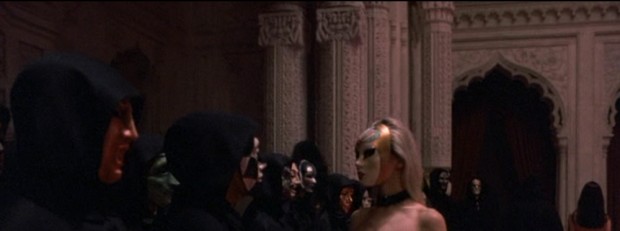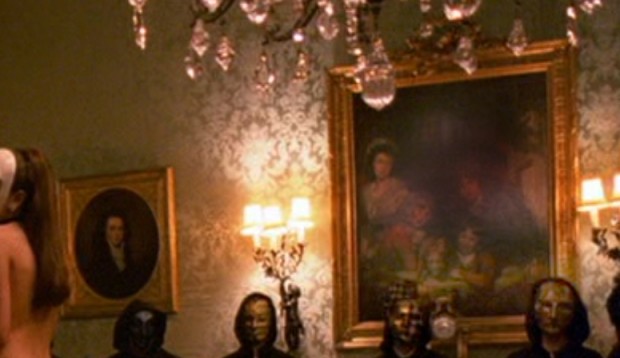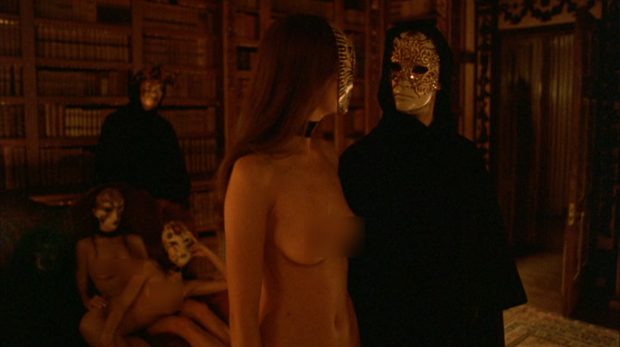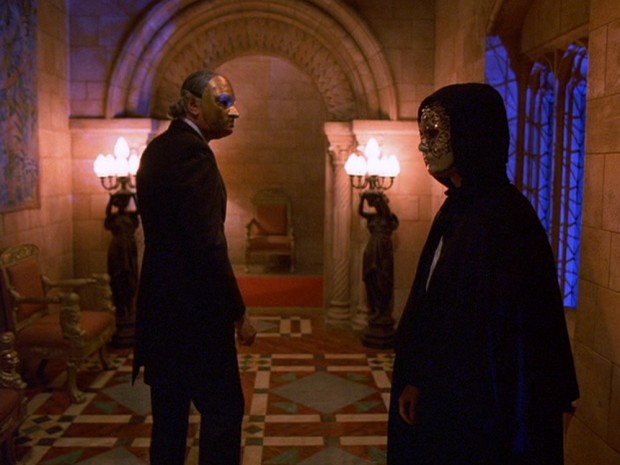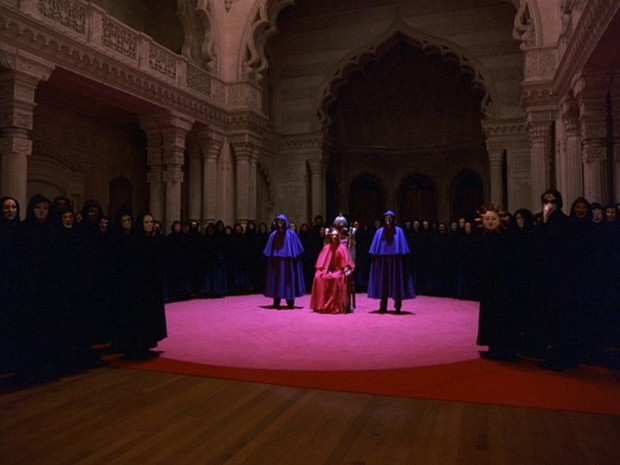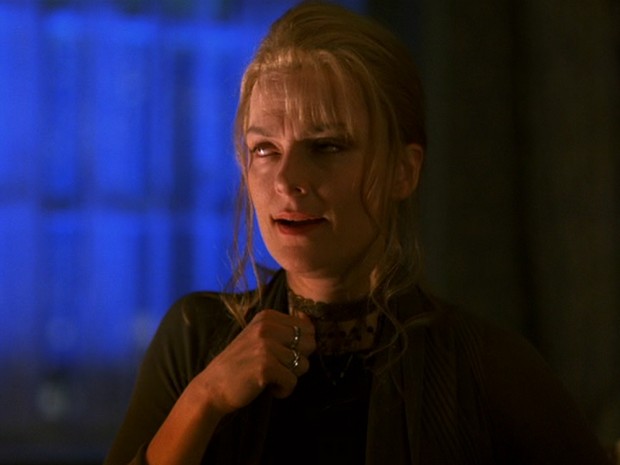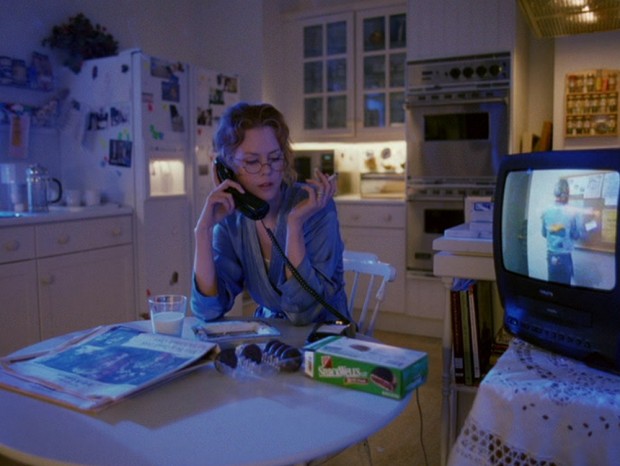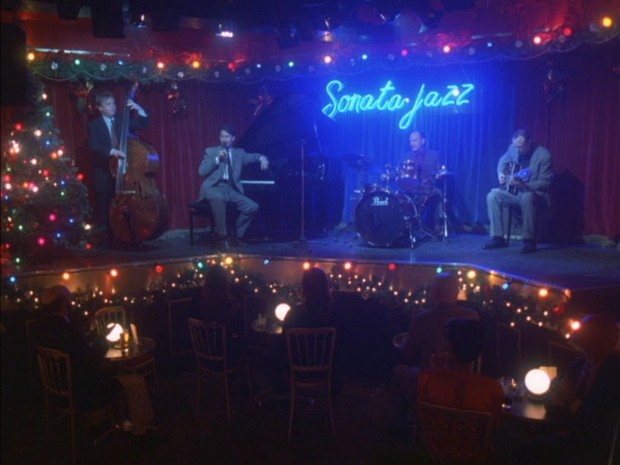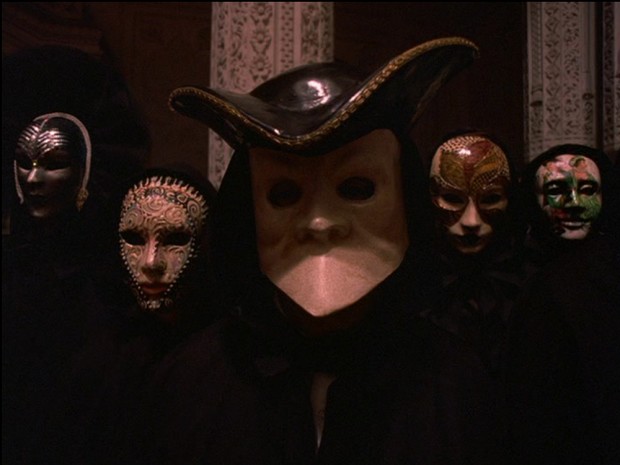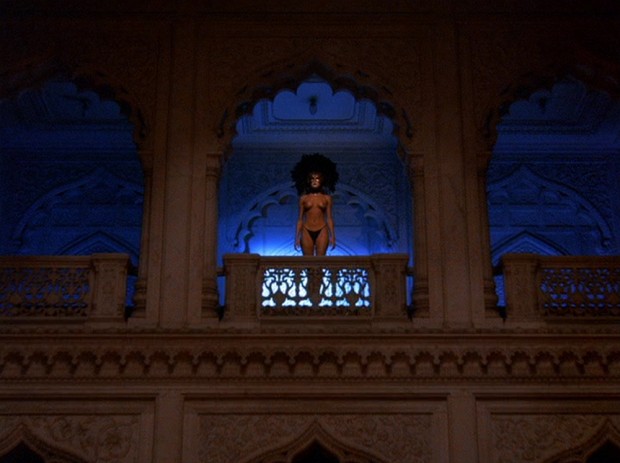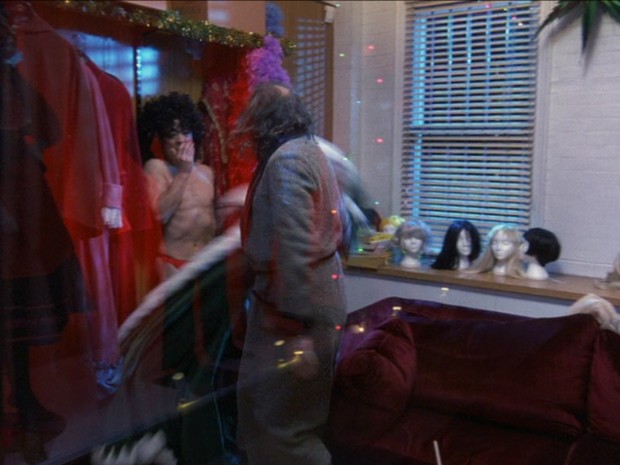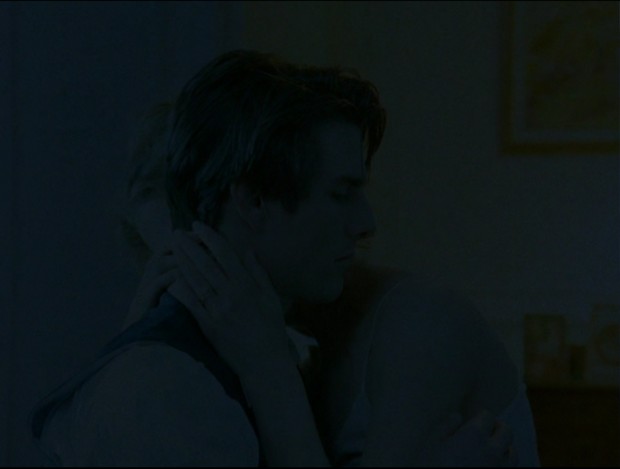STANLEY KUBRICK'S EYES WIDE SHUT

Go to TOC for this film ( (which has also a statement on purpose and manner of analysis and a disclaimer as to caveat emptor and my knowing anything authoritatively, which I do not, but I do try to not know earnestly, with some discretion, and considerable thought).
PART FIVE
TOC and Supplemental Posts | Part 1 | Part 2 | Part 3 | Part 4 | Part 5 | Part 6 | Part 7 | Part 8 | Part 9 | Films Home
LINKS TO SECTIONS OF THE ANALYSIS ON THIS PAGE:
Somerton, Shots 260 through 361
The 7M96 cab. The doorkeepers. Somerton as the fabled classical labyrinths of Troy and Jericho. Exterior and interior locations. The dressing room mirrors, the screen, and the donning of the mask. Masks as submerging ego so the deity represented may manifest. The mask and the carnival. The Dionysian aspect. Fish. The association of the labyrinth's Ariadne with Dionysus. Bill literally enters the spotlight. The Bauta figure. Movement of participants echoing the mannequins in their continually being out of their designated order. Relationship of the library to the private Rainbow office and dressing room. Switching. Abigail. Another look at Sandor. Freedom.
Alice's Dream, Shots 362 through 379
Another change of location of the paintings. Differences between Alice's dream in the screenplay and the film. An examination of Alice's dream in the screenplay and how it relates to the film. The Shekinah and the desire to unity. On the garden of Eden, Noah, Dionysus, and the naval officer. Carnival and the flood. The state of affairs as Bill begins the next phase of his journey.
SOMERTON
THE 7M96 CAB - THE DOORKEEPERS - SOMERTON AS THE FABLED CLASSICAL LABYRINTHS OF TROY AND JERICHO - EXTERIOR AND INTERIOR LOCATIONS - THE DRESSING ROOM MIRRORS, THE SCREEN, AND THE DONNING OF THE MASK - MASKS AS SUBMERGING EGO SO THE DEITY REPRESENTED MAY MANIFEST - THE MASK AND CARNIVAL - THE DIONYSIAN ASPECT - FISH - THE ASSOCIATION OF THE LABYRINTH'S ARIADNE WITH DIONYSUS - BILL LITERALLY ENTERS THE SPOTLIGHT - THE BAUTA FIGURE - MOVEMENT OF PARTICIPANTS ECHOING THE MANNEQUINS IN THEIR CONTINUALLY BEING OUT OF THEIR DESIGNATED ORDER - RELATIONSHIP OF THE LIBRARY TO THE PRIVATE RAINBOW OFFICE AND DRESSING ROOM - SWITCHING - ABIGAIL - ANOTHER LOOK AT SANDOR, THE HUNGARIAN - FREEDOM
SKIP ALL THIS AND TAKE ME TO THE TL;DR WRAP-UP AT THE END OF THE PAGE.
Before I begin, I'll note that I am using for my screen grabs a version of the film that has the digital cloakings that were inserted after Kubrick's death. It just makes it easier for me, blurring things so that this page doesn't get too not safe for work.
260 LS A cab crossing a bridge away from Manhattan. (1:08:40)
261 MS Bill in the cab with the lights of the skyscrapers behind him. (1:08:48)
262 MS Alice, this time entirely nude, with the officer. (1:09:02)
263 MS Bill in the cab. (1:09:13)
264 LS Crossfade to highway. (1:09:19 begin crossfade, ending at 1:09:22)
The taxi takes an exit as a horn sounds.
 261 |
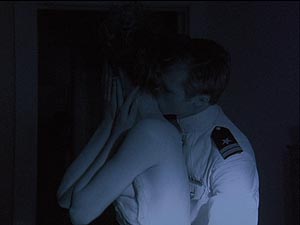 262 |
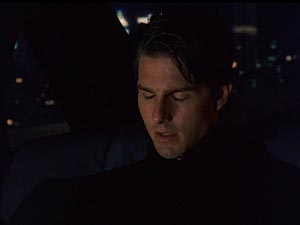 263 |
 264 |
265 LS Crossfade to street in town. (1:09:30 begin crossfade, end at 1:09:33.
The cab now is traveling through a street in a town, a Happy Holiday sign hung over it. We see the license plate and that it is again cab 7M96, the same cab that had cut Bill off at the corner and made it easy for Domino to approach him, the same cab which had delivered him to the Rainbow. They pass a gas station on the right. A tall building beyond with twin peaks looks suspiciously like a funeral home but was perhaps chosen for the doubling nature of its architecture.
Actually, I followed up on the funeral home, hoping to discover where it is, and did. It was tough but I found it. We barely make out Route 106 on the sign. Then a shop that is named Wagner, and then a Getty gas station. The shop and the gas station no longer exist. But in the distance is a brightly lit side of a building with two gables. My thoughts? The only place on a road like this that will be that large and have two gables is likely to be a funeral home. And that's how I located the Oyster Bay funeral home, which is the one seen in the film, on Route 106, where it's a two lane road in Oyster Bay. Later, we have signs showing Bill going to Glen Cove, and Oyster Bay is beyond but near enough there.
Google map for the Oyster Bay funeral home.
This post on the blog gives a little more information, comparing the funeral home with the Overlook and the Enchanted Hunters hotel.
As far as curious etymological syncs go, when Bill and Alice go to Victor's party, Victor mentions the osteopath Bill sent him to and how Bill should see his serve now. Osteopathy is a holistic approach to medicine in which the physician treats the whole person. The word osteopath comes from the Greek word for bone, osteon. It's related to the Greek ostrakon "oyster shell". And here we now have Bill finding himself in Oyster Bay, where we see the funeral home with its twin gables. Recollect, too, that Amanda had on the ring finger of her right hand a giant pearl, simulated yes, and likely a version of what is called a "poison" ring, with a secret chamber. But pearls come from oysters and Victor later tells Bill that Amanda was the woman he met at the orgy.
It is after we see the (unidentified in the film) Oyster Bay funeral home that the scenery changes dramatically and Bill is now traveling through a kind of pine forest which (as far as I can tell) is atypical for the area. We may have been led out here to Oyster Bay, but where we go from Oyster Bay is another matter entirely and has more in common with Jack's drive through the evergreens up to the Overlook Hotel in the mountains in The Shining than any idea of a real location near Oyster Bay. I have pointed out in the second section how when Bill enters his office we see the S "wave" of the counter, which leads down to a small evergreen, and how it mimics one of the shots in The Shining of Jack's driving through the forest on an S-shaped road. In Bill's office we also see seating that is in the same S wave shape and at the end of that was also a Christmas evergreen. Here, when the car reaches the funeral home and suddenly moves into the evergreen forest, we are removed to a place which is other-worldly and has been anticipated by that S wave and Christmas evergreen in Bill's office.
266 LS Crossfade to a street through the woods. (1:09:34 begin crossfade, ending at 1:09:38.)
A view from behind the cab of it traveling through an unlit woodsy area, a fence on the right.
One may or may not have a vague sense of pareidolia, of seeing masks briefly looming in the trees. The columns of the funeral home linger long in the upper right screen, mixing with the columns of the trees.
Brightening shows just how long the superimposition lingers.
At an intersection we see the rear of an inverted triangle street sign. Beyond that is another triangle (not inverted) street sign. As we pass, the shot is such that the two triangles briefly touch points but don't merge.
I'm returned to a crossfade at the film's beginning in which we go from the street exterior Victor's to Bill and Alice walking down the hall in Victor's residence. Again, we have in the mosaic floor the tips of triangles touching and these being briefly superimposed on the street before Ziegler's home.
Shot 267 also has in it a crossfade that recalls, again, that crossfade as Bill and Alice enter Victor's mansion.
267 MS Begin crossfade to Bill, the woods briefly superimposed over his face. (1:09:41 begin crossfade, ending at 1:09:45.)
The forest layered on Bill's face again recalls the same alternating bars of light and dark superimposed on Bill's face when he was entering Victor's party. Instead, here, Bill is going to the orgy, but it seems that a parallel is being drawn, a link is being made, between Victor's party and the party at Somerton. They also might bring to mind the columns of the front portico of the Oyster Bay funeral home.
Perhaps you will recall how I had pointed out in section one that the crosswalk, superimposed on Victor's hall, leads to a display case, but that display case is pushed in front of a door, partly concealing it. Interior shots of the real Lutton Hoo show the same case sitting to the side of the double door. For some reason Kubrick chose to conceal the door, but not completely. I've the feeling it has to do with Somerton, when observed in combination with how this crossfade has elements in it that are recreated and introduce us to Somerton.
268 LS The road to Somerton. (1:09:49)
The cab slows down on a country road as Somerton comes into view, two men in black standing outside a large gate. The cab pulls to a stop past the entrance and shuts down.
As the cab pulls up to Somerton, we can see a reflective white sign in the distance and the sign for Somerton is on the right side of the gate.
269 LS The cab pulling to a stop past Somerton. (1:10:11)
We've a switch here. Instead of the white sign there are the signs for Interstate 495 (barely seen) in the distance, and the Somerton sign is on the left side of the gate. The scene from the interior of the cab, one could say, is different from the one exterior the cab. The flip of the Somerton sign to the other side of the entrance falls in the line of Kubrick's horizontal flips/reorientations.
Somerton. Perhaps as in summer, an opposing time of the year. Perhaps not. Elsewhere in the movie the screen is perpetually decorated with Christmas tree lights, but not here. *
Shamar is the Hebrew for to hedge about (as with thorns), guard, to protect, and the term is also for the priestly doorkeeper of the sanctuary. There could be some word play in this direction as at Somerton Bill encounters numerous gatekeepers, the two outside being only the first guard through which me must pass. After Bill's trip to Somerton, returning home we will have a focus on two paintings, both to do with thorns. The "Thorns and a Little More Snow" painting in the office, and, outside Helena's bedroom, "Flowering Hawthorn and Bracken".
As for Somerton, I note in my analysis of "The Shining",
In "Eyes Wide Shut" we have a reference to 237 (the room of the haunting and the strangling of Danny). After Bill's visit to Somerton, the next day he revisits the situations of the former night, even going to Somerton again, where he is warned against making further inquiries. The city's streets are a virtual maze. Also, Somerton, as here, brings in the oppositional duality of summer and winter and their solstices, the action of that film taking place at Christmas. However, making everything all the more interesting, Somerton is also the spot of a famous turf maze in England. Bill, revisiting the situations of the previous night, finally realizes he's being tailed as he passes a building numbered 37 and sees a bald man following him passing a building numbered 23. As Bill becomes increasingly fearful he is viewed standing before a restaurant with the address 237, which we will momentarily see is the Verona Restaurant. He waves for a cab but is unable to hail one. He crosses the street and takes refuge before a news kiosk, the bald man now distinctly threatening, there being no doubt he's been following Bill, the Verona Restaurant seen behind him as he gazes up the street at Bill. Bill picks up a paper that reads "Lucky to Be Alive." We will shortly find inside it a story on the "beauty queen" (a hooker) who had died of an overdose and that no foul play was suspected as her door was locked from the inside. Beside that story is one on a hostage situation that ends with speaking about the harm of mental violence. There are other linking elements but these are some of the main ones.
Verona comes from Veronica and has taken on the folk meaning "true image", Veronica being supposedly the woman who, when he was on his way to his crucifixion, wiped the face of Christ with her veil, thus recording his true image, an icon of him.
Bill Harford is later told that he was indeed followed, in order to frighten him, but that his interpretation of the situation is wrong, that the hooker, who had taken a Christ-like redemptive posture in the story, wasn't murdered as Bill believes her to have been. In that situation, as with the one here, we have characters operating in mazes in which all is not as it seems to be, neither for the characters nor the audience.
In all these films, characters are submitted to extremes of mental violence for the supposed purpose of making them conform or saving them from some defect or action of their own. In Full Metal Jacket the characters are re-educated in the Marines, suffering mental violence for the supposed sake of their own survival, even though they are told that should they die, their deaths as individuals will not matter.
In light of Somerton being also the place of a famed turf maze, and a likely reference back to the hedge maze of The Shining, Shamar and its idea of guarding and doorkeeping seems a good match.
I've noted elsewhere possible associations with Troy (the end of the age of heroes) through Helena and Victor's wife having also a name that is a version of Helen, also possibly Electra and some other figures associated with Troy having perhaps been alluded to. The turf maze at the real life Somerton is actually called a Troy Maze, and often such mazes were called Troy Town, Walls of Troy, or Julian's Bower. Does Julian perhaps even link with Julienne Davis playing Amanda, who is said to be the woman at Somerton? There are various reasons postulated for these maze names but no one quite seems to know the why. Julian's Bower is said to be based on Julius, son of Aeneas of Troy. A legend has it that Troy's walls were built to be so complex that enemies would be trapped in them. The magical spiral in the book Requiem in the Harford bedroom was stated to trap instead demons (not so different a concept). Wikipedia points out that labyrinths were associated with the name Troy in ancient times, art on a wine-jar depicting a 7-ringed labyrinth marked with TRUIA (Troy). The maze at Somerton happens to be based on that ancient seven-ring classical labyrinth.
The classical figures I've so far brought up, Agamemnon, Ajax, Helen etc., are all associated with Troy. And one may also see this same association with the prostitute, Rahab, a woman of Jericho, who I discussed in section one. Troy, given as being enclosed in a seven-walled labyrinth, sounds much like Jericho, surrounded by the famed seven walls that fell with the blowing of the horn.
An article on labyrinths mentions both Troy and Jericho being examples of Aegean cities protected by the "Game of Troy", which was a protective enchantment "woven through the labyrinth by dancers. The line of dance was called Ariadne's thread. Invading forces in Troy and Jericho managed to unwind this thread by circling the walls of the labyrinth and playing music to a set pattern."
We see this Jericho labyrinth in the below rendering.
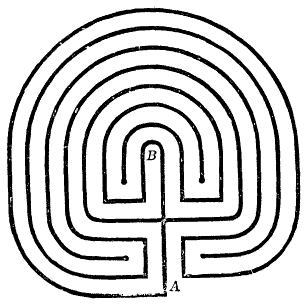
Classical labyrinth upon which Somerton labyrinth is based
The two images above are from Wikipedia. The blog Ishtarsgate offers the below drawing of the Etruscan wine jug showing the Troy labyrinth in conjunction with images of war and sexual intercourse.

Troy labyrinth depicted on Etruscan wine jug
Again, a clearer depiction:

Within the labyrinth is the name Troy/Troja, mirrored.
So, I don't believe it has been too outrageous of me to propose that in Eyes Wide Shut we've had the same exploration of the labyrinth as had in The Shining and that there has appeared Rahab, of Jericho, and legendary luminaries associated with Troy.
The Route 106 sign gives us a physical link to Troy/Jericho, as Route 106 passes through Jericho, New York.
But if a sign for Route 495 is seen in front of the gates of Somerton, we couldn't now possibly be anywhere near Oyster Bay or Glen Cove, for 495 is the interstate that delivered Bill out here and is a number of miles away. Now, if one was instead in Jericho, one would see such a sign for 495. 495 passes right through Jericho.
Keep in mind, however, this is no "real" place. We are in the equivalent of the superworld/underworld, the place of the dead and of heroes and of myth.
The exterior of "Somerton" was filmed at Mentmore Towers, a Rothschild house that was long owned by the Transcendental Meditation Movement, while the interior was filmed at Elveden Hall, close to A11, an estate purchased by the Maharajah Duleep Singh--the last Maharaja of the Sikh Empire and the first Sikh in England--and rebuilt to resemble the palaces he knew from childhood. Duleep Singh was the Maharajah who presented the Koh-i-Noor, "Mountain of Light", diamond to the Queen. His predecessor had willed the diamond to the Jagannath Temple but after his death the British claimed the Punjab as part of the British Empire in India and demanded the surrender of the diamond to the Queen of England.
I note the above information about the diamond because of Kubrick's occasional use of diamond shapes, and because later Bill will be observed, when followed, before the Diamond House, in the jewelry quarter of London.
Sikhism is a religion that believes in equality rather than caste, respects other religions and doesn't evangelize, rejects sacrifice, and focuses on meeting God with pure love.
As far as politics goes, what seems significant to me is that at the Overlook in The Shining there were decorative Indian themes and there were allusions to American Indians displaced by the Europeans and then the US of A. With Elveden we bring in the history of the British East India Company, British imperialism, the subjugation of the Sikh empire, the imprisonment and exile of the Maharani and the deposal of Duleep Singh when he was child, he to be anglicized (he converted to Christianity) and forbidden to meet in private with Indians other than servants. Then he was sent into exile. In Britain.
270 MS The cab driver, Bill in the background, the two men seen out the back window of the cab. (1:10:16)
The cab driver cuts on the overhead light.
CAB DRIVER: Ok, that's $74.50.
BILL (has out his billfold, takes out some money): Seventy-four fifty. Okay, all right. (Hands him some bills.) There's eighty. Now, I promised you fifty bucks over the meter, right?
Bill has taken out a hundred dollar bill, replaced his wallet in his inner coat pocket, and tears the century note in half. When he replaced his wallet in his pocket we were given the opportunity to see his bow tie and that he is not yet wearing his cloak.
BILL: I'll make that a hundred. If you wait for me. Just let the meter run, I'll give you the other half, plus the meter, when I get back. Okay?
CAB DRIVER: How long you gonna be?
BILL: I don't know, maybe an hour or more, but maybe only ten minutes. I'll leave my stuff here in the back. Okay?
CAB DRIVER (taking the money): Okay.
Bill climbs out of the cab.
He's still gaming here, the way that Bill handles the cab driver. He hands him $80, which is only $5.50 over the meter. But Bill had promised $50 over the meter. He pulls out a $100 and tears it in half, making his proposition that the driver wait for him and receive a full century note. He brandishes his big smile, selling the idea, brimming with confidence, too, that the money and his smile and his charm will make the sale.
Kubrick's having Bill tear the 100 dollar bill in half again works in with the idea that we're at a "center" here, a dividing line, such as the center of a maze, as I've discussed in the previous section.
For more on this see The Relationship Between Bill's Tearing the Hundred Dollar Bill in Half to the Torn News Article of the Beauty Queen.
271 LS Street view of Bill climbing out of the cab. (1:11:03)
A bird crying in the background, Bill approaches the two men.
Bill already looks like he's wearing a mask, the way the planes of the face play in the light. I've merged different captures of him as he approaches the gate and enlarged so one can tell what I'm talking about. Click on the image for the enlargement. (I don't have a Blu-ray. Would be interested in if a Blu-ray is clearer on this.)
HEAVIER SET MAN: Good evening, sir.
BILL: Good evening.
HEAVIER SET MAN: Can we be of any help?
272 MS Bill and the two men, the gate in the background with its signs that read Private, No Trespassing. (1:11:17)
BILL: Well, I suppose you'd like the password.
HEAVIER SET MAN: If you'd like, sir.
BILL: Fidelio.
HEAVIER SET MAN: Thank you, sir. We'll run you up to the house. (Points to a red car behind the gate.)
273 LS Crossfade to the exterior of the mansion. (1:11:28 begin crossfade, end 1:11:29.) The crossfade has the gate superimposed over the mansion and its entrance.
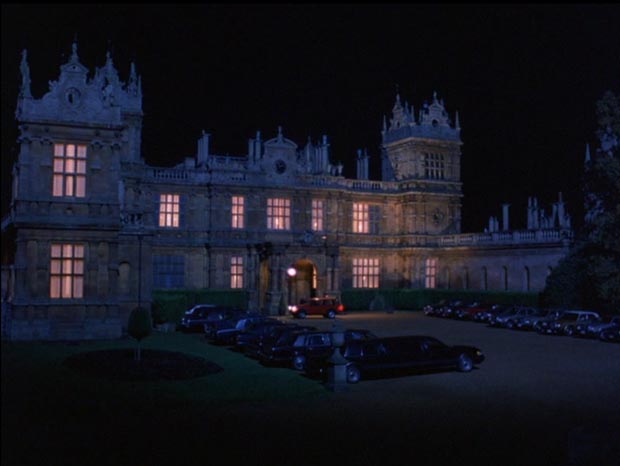
The red car carrying Bill to the mansion drives through a lot filled with stretch limos and other cars and pulls around to the front entrance where two other men stand. A clock observed on the facade reads 1:55. When Bill had was on his way to the Nathanson's we had observed a clock that read 1:22, which would have been an impossible time as we know it was earlier and that it was 12:10 when he was later with Domino. When he was with Nick at the Sonata he was told the party would start around 2:00 and that's in line with this clock reading 1:55. So, what of that 1:22? This may sound a bit odd, but if you turn a 2 around it can look like 5. Trust me on this, I'm dyslexic. I wonder if the 1:22 is intended to be 1:55 in reverse. We have one obvious link between the Nathanson's and Somerton being Mr. Nathanson having died and the curious transition into an other-worldly place of evergreens occurring as Bill's cab passed the Oyster Bay Funeral Home on the way to Somerton. I'm not saying the Nathanson's is the same as Somerton, but that we have a replaying of some elements. They are connected. The urgency that Marion expresses in her love for Bill, and his cool response being that they don't even know each other, can be seen as being played out here with Bill for some reason becoming obviously immediately enamoured by the raven woman, so much so that he asks her to leave with him. It is a peculiar and immediate bond though he doesn't even know her.
We also had at the Nathanson's our first sighting of a mask, an antique one near the bedside of Mr. Nathanson.
274 LS One of the doormen opening the car door for Bill. (1:11:44)
Bill exits and walks up to the large front doors. A third man opens the door for him. We see he is wearing his cloak beneath his coat as its hem has begun to escape.
Lion head knockers are evident on the doors here. In the next shot we shall see that they are absent and the doorknob position is shifted, but Kubrick has retained here seeming evidence of the wagon wheel arch, just as we will observe a wagon wheel arch when inside.
If Somerton is enclosed within a 7-walled labyrinth, it's to be noted the wagon wheel arch observed here has 7 rays leading to its interior. In shot 275 we will see two of these arches in the entry. 180 degrees plus 180 degrees. As if the split circle, like the 100 dollar note that bill tore, promising the other half when he returned. A place of division and thus one also of uniting, the magic circle (of sorts) where the halves meet.
275 LS Bill entering the front entry. (1:12:03)
Outside, the attendants wore no masks. But now we are inside and the attendants are masked. Bill enters on a red carpet through red drapes trained back with gold pulls. A man in a gold mask asks for the password and Bill says, "Fidelio." When Bill delivers his password one may be reminded of the scene at the Sonata where Bill holds Nick's napkin while he writes on it "Fidelio", the arch of a lime slice in Nick's glass to the side. This lime section recalls the arch above the Somerton door.
The man thanks Bill and takes his coat. Bill now puts on his mask and advances past walls hung with old tapestries and statues of women holding lights, following the sound of sonorous ritualistic music, Joceyln Pook's "Masked Ball" which I read is a variation on an earlier piece of Pook's titled, "Backwards Priests".
We've been introduced to the masks through the mask at Marion's, then the prostitute named Domino who had several masks in her apartment, and finally we have Bill at the mansion where this mysterious party is being held, everyone masked.
I've read that Bill's mask is based on Ryan O'Neal's face in Barry Lyndon. If this is the case, it's to be remembered that Barry, entering the upper echelons of society (their faces often heavily masked with make-up) was never accepted as one of them, despite his marriage to Lady Lyndon and having a child with her, just as Bill here is out of his element. Personally, I've a difficult time seeing Ryan O'Neal's face in Bill's mask. I instead see Ryan O'Neal's face in the girl at the Rainbow shop.
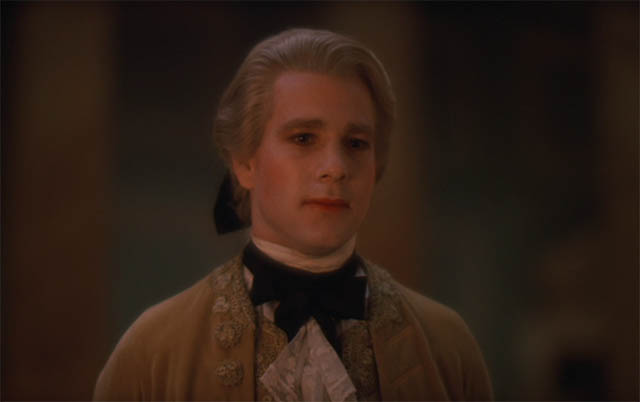
The little Pierrette, as she is described in the book upon which Eyes Wide Shut is based, is the one who encourages Bill to rent, rather than a regular cloak, one lined with ermine. When Bill returns a second time, her doll-like appearance emphasized, she seems even to be a mocking, taunting puppet. She is most, however, a blank, a riddle, her exterior offering no sensation of what thoughts are harbored behind her gaze, just as Barry is a throughly impassive and unsearchable creature when in paint.
INNER DOOR ATTENDANT IN GOLD MASK: Good evening, sir.
BILL: Good evening.
INNER DOOR ATTENDANT IN GOLD MASK: Password, sir?
BILL: Fidelio.
INNER DOOR ATTENDANT IN GOLD MASK (steps forward to take Bill's coat without asking for it): Thank you, sir.
We see here how Bill's shirt front should have looked in the cab had he been wearing a cloak at the time, and that he hadn't been. The reason I've bothered to point this out is because I think Bill's coat itself has doubled as the cloak previously. The use of the mask and cloak here, once he's entered the mansion, are symbolic representations.
Bill hands over his coat to the attendant. Having taken his mask from a pocket inside the coat, he slips it on, and pulls up the hood of his cloak.
Check Section Four, beginning about shot 255, for what I have written on the dressing room mirrors in the opening of the film and the office/dressing room area at the Rainbow. We have a couple of instances of screens in the film as well and these screens tie in with all this. I had noted in section four that the four panels of the closet in one scene, becoming seemingly 3 panels in another, is intentional. Here we have a screen with 4 panels, which is the number of mirrors in the closet door when Alice was in the dressing room. Later, when Bill visits the hospital, we will see a screen with 3 panels, which was the seeming number of mirrors fronting the closet when Bill was in the dressing room.
I had noted that when Bill passes before the mirrors he briefly disappears in the panel between the one that shows the window with its red curtain drawn back by a gold pull and the panel that shows the books in the shelves on the opposite wall. I have written elsewhere of how Schnitzler's vehmic judges, in Glück‘s Traumnovelle, can be seen in the red curtains in the Harford dressing room. Those red curtains in the Harford apartment may morph also into the red drapes to either side of the entry door in this shot. Putting on his mask, Bill is effectively "disappearing", as represented in his not appearing in that middle panel.
We have a nice "tricorn" effect of lights radiant above his head as he puts on the mask, caused by the lamps behind him. We'd also had something similar to this behind Bill when he went down the stairway into the Sonata Jazz club.
In the secular world we think of masks as simply concealing identity, when their original intent was to represent the submergence of the ego so that the deity represented in the mask could come forth. The transpersonal.
The association with the Venetian masks makes a direct connection to the Carnival season, which brings into the symbolic fray earlier feasts of Saturnalia and Dionysus, but seems to have transformed with Christianity into a blow-out before the forty day abstinence of Lent, people feasting and butchers getting rid of their fresh stores of meat before the populace could no longer partake (carnival deriving from carnem levare, which means taking away or removing meat). Concerning the meal laid out on the coffee table in the Rainbow office (the Chinese dinner) as it is all red it seems to me that we have already there a reference to this feasting, this getting rid of meat, and the implied tearing apart of the victim, too, which we find in certain Dionysian stories and myths. Which is what is happening to Bill, at least psychologically and spiritually, everything he knows being ripped to shreds to be replaced by a new outlook on his relation to the world.
Fish is however permitted during Lent and we already saw on the Rainbow street the Pescado restaurant (pescado meaning fish). When Bill later goes to Gillespie's most of what will be on he menu is fish.
An easy quote from Wikipedia on Dionysian revelry:
Following the torches as they dipped and swayed in the darkness, they climbed mountain paths with head thrown back and eyes glazed, dancing to the beat of the drum which stirred their blood' [or 'staggered drunkenly with what was known as the Dionysus gait']. 'In this state of ekstasis or enthusiasmos, they abandoned themselves, dancing wildly and shouting 'Euoi!' [the god's name] and at that moment of intense rapture became identified with the god himself. They became filled with his spirit and acquired divine powers.
This is partly what I was alluding to when I pointing out how Kubrick has depicted Nick, Dominio and Marion with this kind of glazed eye effect, Marion showing this before her declaration of love to Bill.
The attendant passes along Bill's coat to another who leaves with it.
276 MS Bill is shown into the rear of the cathedral-like area. (1:12:38)
NOTE: Thanks to Eli for pointing out that I had missed this shot.
Bill exits this area through another door held for him by yet another attendant and is directed by yet another past red drapes into a cathedral type room, individuals in black cloaks, hoods and masks lining the walls of the first floor and the balcony. A man in a red hood and cape stands in a circle of individuals in black capes and masks. He is the Hierophant. **
Bill had been invited, though consistently we are given the impression that he is an intruder. Note that Bill is indeed an honored guest. The women and Hierophant are in a large lit circle. To the right forefront there is a smaller spotlight for Bill.
Bill moves into the spotlight as if he intuits it is where he should stand.
It's an odd thing to do for a supposed interloper who should like to keep as low a profile as possible. With the spotlight, Kubrick depicts Bill as a guest, someone called here, an initiate of sorts--and I don't mean literally, I mean in the way of dream-time. He is there by invitation, no matter the subsequent appearance of things.
Nick Nightingale is seen beyond, in a white tux, playing electronic keyboards, his back to the proceedings. Previous to this he has been playing acoustic.
You'll notice a third spotlight in the room. It is on Nick. Nick certainly doesn't need light as he plays blindfolded. Why should a musician be spotlit? Because he, too, is very much a part of this. And, again, I don't mean in a literal, realistic sense. I mean in the mythic sense of the underworld, Nick Nightingale being the mephistopholean figure who has assisted in guiding Bill here. Devilish or trickster figures often give mere mortals the means and ways to visit forbidden territory.
The suggestion is, the way this is staged, that the music is live rather than recorded and the Hierophant is doing the singing, which would be impossible as it is backmasking of what's said to be a Romanian chant.
The lyrics (before backmasking) are purportedly the following, a fairly standard litany of petitions:
And God told to his apprentices...I gave you a command...to pray to the Lord for the mercy, life, peace, health, salvation, the search, the leave and the forgiveness of the sins of God's children. The ones that pray, they have mercy and they take good care of this holy place.
Turns and reversals are properties of a labyrinth.
277 MS The Hierophant in the group of 11, from the edge of the circle. (1:13:09)
Pausing the anointing with the censer, he taps the ground with his staff and all bow. He taps twice, all kneel, and he continues the anointing.
I had erroneously first thought there were 12 women in the circle, but then John Bourassa made me aware there are instead eleven.
As for the censer (thurible), Wikipedia states, "The smoke of burning incense is interpreted by both the Western Catholic and Eastern Christian churches as a symbol of the prayer of the faithful rising to heaven. This symbolism is seen in Psalm 141 (140), verse 2: 'Let my prayer be directed as incense in thy sight: the lifting up of my hands, as evening sacrifice.' Incense is often used as part of a purification ritual."
278 MS Nick blindfolded at the piano. (1:13:42)
279 MS Bill in his mask. (1:13:52)
280 LS The Hierophant in the group of 11. (1:13:56)
When we return to Bill, he is now out of the spotlight.
The man in red completes his action with the censer and taps his staff. He taps it again and all in the circle stand and drop their cloaks.
281 MS The 11 women, from the edge of the circle. (1:14:11)
The camera passes about the circle so we may view the statuesque bodies of the women which have been exposed with the dropping of the cloaks. I wonder if one reason Kubrick twice focused on Alice undressing and dressing, in particular her buttocks, was so that we would search and see if her posterior matched any one of the 11 in the circle.
282 MS Masked observers. (1:14:45)
Among the masked observers we see one wearing a gold mask of the style later worn by the supposed Victor.
283 LS Nick with the circle of women in the background. (1:14:53)
The women, at a distance, the way the light falls on them, all appear to have silver hair.
The Hierophant stamps his staff and the women all advance toward him and kneel.
284 MS The 11 women from the edge of the circle. (1:15:03)
The women pass from one to another a stylized kiss.
285 LS Bauta Figure in the balcony in his mask and tri-cornered hat. (1:15:37)
Up on a balcony, zoom in on a man in a tricorner hat and woman turning to look down on Bill. The audience is under the impression this is Victor. His masked character is the Bauta.
The Bauta figure is an interesting choice for an association with Victor, for the Bauta came to be a costume that could only be worn by citizens in Venice and one was obligated to wear it at certain political events in which a democratic anonymity among peers was desired.
Now we do have the strong feeling this is Victor. However, let's return to the Rainbow costume shop and Millich's peculiar entreaty to Bill to identify the problem of his balding head (reminding of a tonsure). Bill told him to see a trichcologist. Never mind that "tri" (three) is not the same as "trich" which comes from a Greek word meaning hair. There are two ways to pronounce it, one with a short and one with a long "i" and Bill went for the long "i". We should also see in the man with the tricorner hat this Millich, proprietor of the Rainbow costume shop.
286 MS Bill. (1:15:53) Bill realizes he's being stared at and looks up at the balcony.
287 MS Bauta Figure and woman in black tear mask. (1:15:59)
The man nods at Bill.
288 MS Bill watching the balcony. (1:16:06)
Bill nods in return.
289 MS Bauta Figure and woman in black tear mask.
They return to watching the floor.
290 MS The 11 women in the circle with the Hierophant. (1:16:21)
The Hierophant approaches a woman to the left of the key woman in the ritual I'll call the Black Feather Woman, stamps his staff, and she rises. They nod to each other and she leaves the circle. He approaches a woman to the right of Black Feather Woman and follows the same procedure with her.
During this we are able to see a "downstairs" Bauta as well who is on the left side of the room as one enters from the rear, but the right as one faces it from the pianist.
He approaches a woman in a gold mask much like those the door attendants wore, and she now leaves the circle. He continues to another woman. Beyond her we see the first of the 11 women leaving the area with one of the cloaked observers.
Is the Black Feather Woman Amanda? Victor later says that she was, but she is identified in the credits as played by, instead, Abigail Good, rather than Julienne Davis who played Amanda, so I will simply call her Black Feather Woman.
Julienne Davis has formerly said she was not the woman who played the black feather woman. Recently, in an interview she states that she was originally to have played the part but that she was having problems with a fascia injury from kneeling in this scene and Stanley was concerned about this so he gave her a break for a weekend. When they began filming again he called her in at 2:30 a.m. to come try on G-strings and she declined but Abigail Good obliged. It was then Abigail was brought in as a body double, dressed in a wig so her hair resembled Julienne's, but didn't speak any lines. Julienne says when Bill is walking with the black feather woman down the hall, she is immediately behind, which means she is the woman in the blue-winged, bearded mask.
Knowing this we can look at these shots of the circle and see a pattern concerning Julienne and Abigail, the blue-winged mask and the black-feathered one.
As there are only 11 women in the circle, I'm going to include the blind-folded Nick as the 12th person at the head of it, though he is out of the circle and on the stage.
In shot 276 blue-winged mask is in the 1 o'clock position (facing the entry door) and black-feathered mask is in the 4 o'clock position (by this I mean the third person away). A woman in a gold mask similar to the blue-winged mask, with beard, no wings, is in the 10 o'clock position.
In shot 277, blue-winged mask is in the 1 o'clock position and black-feathered mask is in the 4 o'clock position. A woman in a gold mask similar to the blue-winged mask, with beard, no wings, is in the 10 o'clock position.
In shot 278, black-feathered mask is in the 1 o'clock position and blue-winged mask is in the 4 o'clock position. They have switched places. A woman in a gold mask similar to the blue-winged mask, with beard, no wings, is in the 10 o'clock position.
In shot 280, blue-winged mask is again in the 1 o'clock position and black-feathered mask is in the 4 o'clock position. A woman in a gold mask similar to the blue-winged mask, with beard, no wings, is in the 10 o'clock position.
In shot 281, as they drop their cloaks, blue-winged mask is in the 1 o'clock position and black-feathered mask is in the 4 o'clock position.A woman in a gold mask similar to the blue-winged mask, with beard, no wings, is in the 10 o'clock position.
In shot 283, they have switched places again. Black-feathered mask is in the 1 o'clock position and blue-winged mask is in the 4 o'clock position. A woman in a gold mask similar to the blue-winged mask, with beard, no wings, is in the 10 o'clock position.
The same for shot 284. A woman in a gold mask similar to the blue-winged mask, with beard, no wings, is in the 10 o'clock position.
The same for shot 290. The woman in the 2 o'clock position is tapped away (blond, she wears a mask partly edged in blue). Normally in the 10 o'clock position, now in the 11 o'clock position, the woman in the gold mask with beard similar to the blue-winged mask is tapped away. The woman at the 3 o'clock position (a gold mask, very curly hair) and the one at the 10 o'clock position (a mask with blue edging similar to #2 but the blue also comes over the cheekbones, again blond) are tapped away.
In shot 291 we see a blond woman who was in position #9, a white mask trimmed with gold, leaving with a man, following a brunette woman (black blocky heels, not slingbacks) who was at the #6 position. We don't see the others who had been tapped away.
Then in shot 292, the woman in the blue-winged mask is in the 11 o'clock position and the woman in the black-feathered mask is beside her in the 1 o'clock position. Remember, there are only 11 women so these positions are not concrete like a clock, they are beside each other and I'm assuming Nick, up on stage, is in the 12th position. The woman in the black-feathered mask is tapped away, and then the woman in the blue-winged mask. We see 5 remaining, 6 having been tapped away. Among those remaining is the curly haired woman who had previously been at position 3 and tapped away. She is now at the 9 o'clock position with a woman at the 10 o'clock position. Basically all 5 women are scrunched together on the left.
As for these two masks, the blue-winged mask with the pharaoh-type beard, and the gold one without wings that has the same beard, the masks seem to be reminiscent of pharaohs representing Osiris with their fake beards that jut forward at the bottom. The central part of the headdress may be intended to represent the Uraeus, a cobra emblem. Though I have said one woman was wearing a blue-winged mask (crown), actually only one wing was blue, the right, and the left wing was red, but as the overall effect of the mask is blue it is easy to overlook this red-tipped wing. That one wing is tipped in blue and the other in red is almost pathologically Kubrick.
So we have a pattern where the two women who play Amanada are always at virtually right angles to one another (virtually, not absolutely). One is in the 1 o'clock position and the other in the 4 o'clock position. Sometimes they replace each other. And then finally they are placed next to each other, side by side, in about the 11 o'clock position and the 1 o'clock position, if we count Nick as being between at 12 o'clock.
291 MS First of the 11 women who left the circle. (1:17:03)
We had seen the first woman to leave the circle, the one with blond hair and her masked edged in gold, leaving the room with one of the cloaked observers. Instead now in the background we see a woman with brunette hair leaving while the first woman approaches and "kisses" an observer wearing a black and white diamond mask. They leave together.
The man in the red mask next the black and white diamond mask is one we will later see standing beside the Bauta Figure, and here is placed in such a way that he is directly opposite the downstairs Bauta figure.
292 MS The edge of the circle again, the Hierophant before the Black Feather Woman. (1:17:14)
One sees the shapeless mass of cloth behind each individual. I think the black drape shoved behind the Christmas tree in the room of the grand staircase at Victor's is an allusion to this. And we may also have had an allusion to it with Bill's coat being taken nearly every place he has gone, for at the Rainbow Milich also took his coat but then threw it on the ground, and Bill didn't even appear to notice so it easily escapes the audience's notice as well. It was after Milich threw the coat on the ground that the Japanese men were discovered in the office by virtue of a thump sound that was heard, and that thump could be compared with the thump of the Hierophant's staff on the carpet before the women drop their cloaks.
He taps the staff before the Black Feather Woman and she stands and skirts the edge of the circle to go to Bill. As she reaches him we see 6 women remain in the circle, one of the six rising and leaving.
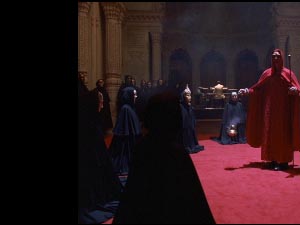 277 |
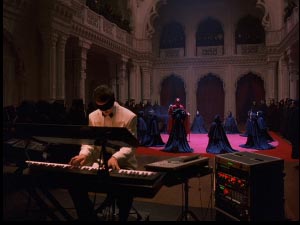 278 |
 279 |
 280 |
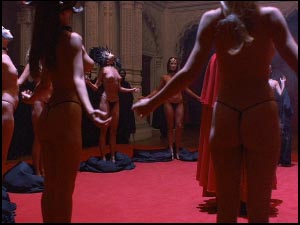 281 |
 282 |
 283 |
 284 |
 285 |
 286 |
 287 |
 288 |
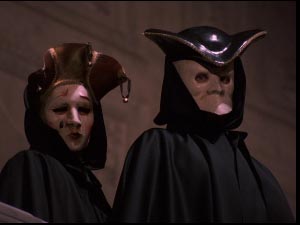 289 |
 290 |
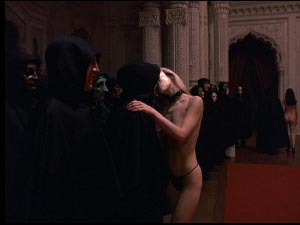 291 |
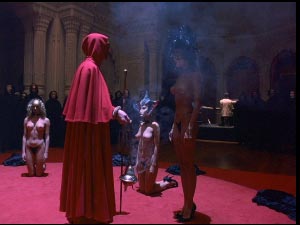 292 |
As I noted in the dance section at Victor's, one doesn't get with stills a sense of the circularity of motion. There, it had been with dance. This is essentially a repeat of that section, the camera continually circling, though it doesn't appear to bear any similarity. But Kubrick does this in all his films, repeating sections, just as the following day Bill will return to every place he has visited.
293 MCU The mask of the Black Feather Woman kisses the mask of Bill. (1:17:44)
294 MS Black Feather Woman and Bill join hands and leave, she leading him out and down a red carpeted hall. (1:18:01)
295 MS Black Feather Woman and Bill from the front as they traverse the hall. (1:18:16)
BLACK FEATHER WOMAN: I'm not sure what you think you're doing but you don't belong here.
BILL: I'm sorry, but I think you've mistaken me for someone else.
We now hear the voice of a woman singing, the chanting having ended. The black feather woman glances behind her at the other women walking the hall with their partners, crossing over a blue or black and white mosaic floor after leaving the red carpet.
BLACK FEATHER WOMAN: Please, don't be foolish, you must go now.
BILL: Who are you?
BLACK FEATHER WOMAN: It doesn't matter who I am. You are in great danger.
Pook's "Migrations" music begins. Migration comes from a word meaning liable to change, and it's certainly representative of people changing positions with one another (or masks) and even people changing under the masks, for we have that as well.
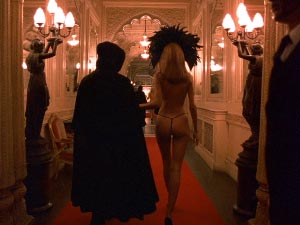 294 |
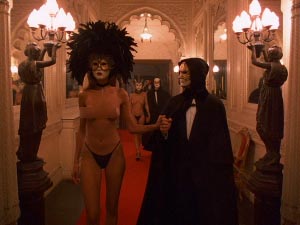 295 |
296 Bill and the Black Feather Woman before a staircase. (1:18:53)
BLACK FEATHER WOMAN: And you must get away while there's still a chance.
A masked man approaches from the right, interrupting.
MASKED MAN: Would you be so good as to excuse us for a moment.

He leads the woman away and up the stairs.
297 MCU Bill watching. (1:19:13)
298 MS The Masked Man and Black Feather Woman climbing the stairs. (1:19:13)
She turns and looks back at Bill.
299 MCU Bill watching the woman leave. (1:19:23)
Bill is continually being interrupted. At Victor's party, when he was speaking to Nick Nightingale, one of Victor's men approached and interrrupted the conversation. Then when Bill was speaking with Nuala and Gayle, another employee of Victor's interrupted and took Bill upstairs where he took care of Amanda. Again, when Bill was with Domino, he was interrupted by Alice's phone call. With the first and second interruptions there was the feeling of an intervention that was intended to keep Bill from Somerton. Now, we have the woman warning Bill to leave and the intervention feels as if to keep him from being convinced to leave. At any rate, as I've said, Bill is here in this other-worldly place by invitation. He does not know the others but he is certainly known! He arrives and the black feather woman immediately goes to him and tells him to leave, telling him he doesn't belong there, despite the fact his identity is hidden by the mask. Even when we do understand her to be Mandy (there remains some intentional doubling going on between Julienne and Abigail), there is no way that Mandy would know this was Bill. He is masked and cloaked and she has been in the circle this entire time so no one could have told her that he was Bill, who didn't belong.
There are several masks we can confidently identify. One is the Bauta mask. Another is the mask of the man who just took away the Black Feather Woman. It is the mask of Christopher Columbus.
This and two other masks have been identified by the maker. Another is the sun mask, and a mask said to represent Mary Magdalene.
With Christopher Columbus we have yet another seafarer, one whose name, columbo, means dove. The story of the flood being spoken of repeatedly due the importance of the rainbow in the movie, it's significant that Columbus (the dove) would lead the black feather woman away, as one can look upon her mask as representing a raven, and the raven and the dove were birds sent out from the ark (given as one story biblically but is actually a blending of two story traditions).
The presence of the Mary Magdalene mask brings in the myth of the sacred prostitute who annointed the feet of Christ, her mask depicting her anguish over his crucifixion. The mask of Mary Magdalene seems to be inspired by Niccolo dell'Arca's "Lamentation of Christ", in which Mary Magdalene and others mourn the death of Jesus after he is taken down from the cross.

The book "Requiem", in the Harford bedroom, has as part of its plot Mary Magdalene seeking to communicate to the main character, Tom, through other women, and his coincidentally being made the possessor of a scrap of Dead Sea scroll that, its writing being in a spiral, communicates a different version of the death of Jesus, Saul/Paul responsible and subsequently imprinting on Christianity his misogynistic view of women. Jesus undergoes a crucifixion, plans having been he would survive and be understood as resurrected in keeping with prophecy. Instead, Saul/Paul has his legs broken and he dies, but Mary Magdalene states that he did indeed resurrect afterward spiritually, and attach to individuals much in the same way as djinn. "But the miracle did happen. After the death, he became pure spirit, haunting his own Church. He waits, like the djinn, haunting all the liars who judge and preach and hate in his name." But there is ever space made in the book for wondering at the truth, for it is repeated several times, "Sometimes you read a holy book, then you go back to it the next day and you swear someone has changed the words."
Why the Niccolo dell'Arca's (a Renaissance artist) version of Mary Magdalene? Because in it we may find the name Nick? Nicole? Nick and Nicole, as I point out elsewhere, mean "victory". Victor? Much like the protean morphing of the djinn.
300 LS One of the women and her partners are observed from the rear as they leave a hall and enter a large two level room in which several nude, masked couples can be observed having sex while others stand about watching. (1:19:29 begin crossfade, end on 1:19:32.)
301 MS Bill walking through the room. (1:19:50)
302 LS Masked and cloaked observers watching the activities, as well as a nude man and woman on a red sofa. (1:19:55)
The camera approaches a couple having sex on a table beside a door.
303 LS Cloaked individuals passing through a room to enter a red carpeted room. (1:20:05 begin crossfade, end 1:20:07)
A number of the masked and cloaked observers stand and sit around a table watching women engaging in oral sexual activity on it, but they are all masked so it's not happening as one supposes. Just as all the kisses are only people knocking masks.
304 MS Bill passing through. (1:20:28)
305 MS The women on the table. (1:20:34)
Most of the paintings escape notice, unidentifiable portraiture. This one below is different. It is a family portrait by William Beechey (identified as such on Reddit) but at a distance the dog is so misreadable as to appear to depict a decapitated head, and the most famous often-painted beheading I can think of is that of John the Baptist. Another famous head is that associated with the tales of Baphomet, which supposedly involved the "worship" of some type of head, but description of it was various. And then there is the so-called brazen head of knowledge, which takes after the head of Mimir, carried about by Odin, which dispensed secret knowledge. Such legends also exist for the head of John the Baptist, that it too granted arcane wisdom to the individual who possessed it. The individuals in the painting peer out over the scene, as if also engaged in watching.
306 MS Bill. (1:20:40)
307 LS A woman in red presides over a couple having sex on a table. (1:20:46 begin crossfade, end on 1:20:48.)
The camera (Bill) now enters a library in which a man on all four serves as a table for a couple having sex.We see, past these individuals and those sitting around watching, another room on the opposite end separated from this one by columns. Just as Bill enters from the right, another person enters that room directly opposite from the left. He stops in the center of that room just as Bill stops. I take the other person to be a a kind "mirror" of Bill.
308 MS Bill. (1:21:03)
Bill enters and stands before a red sofa on which sit two women in almost but not quite matching masks, seeming twins, one leaning over the other, each perfectly still, as are so many of the individuals. Beside them, in the center of the couch, sits a person in a mask so black he or she nearly disappears.
309 LS The couple having sex on the man-table. (1:21:11)
 297 |
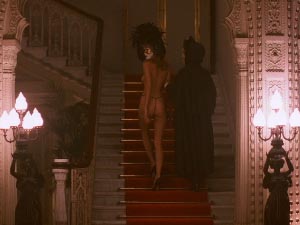 298 |
 299 |
 300 |
 301 |
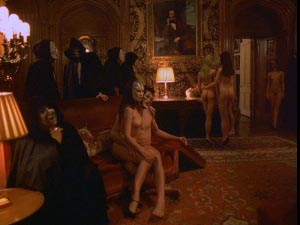 302 |
 303 |
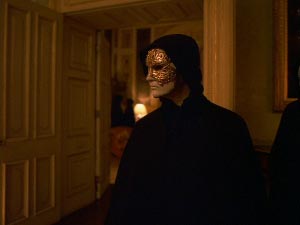 304 |
 305 |
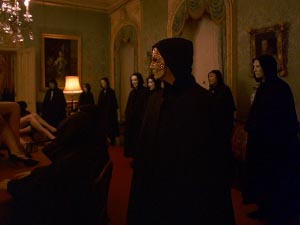 306 |
 307 |
 308 |
 309 |
 310 |
310 LS The Bauta man entering with one a nude woman in a mask ringed with black stripes. (1:21:15)
The stripes may remind one either of a piano keyboard or the black and white striped coat that Domino had worn.
Victor is supposedly the man in the Bauta mask with the tricorn hat, but this person's neck looks younger than Victor's, and he looks not quite as tall.

311 LS Bill, the Bauta figure and woman watching him from behind. (1:21:28)
He directs the woman toward Bill and he leaves while she approaches Bill.
312 MS Bill and the Striped Mask Woman. (1:21:58)
The woman is nude and thus we're able to see by her pubic hair that though she wears the striped mask, her body has changed, the pubic hair and nipples are different than earlier. She has also now the figure and the breasts of the Black Feather Woman. As we've only seen the Black Feather Woman in her thong, we're unable to tell however if she might instead be the Black Feather Woman. Certainly, though, she isn't the woman who entered the room with the Bauta figure. John Fell Ryan's KDK12 blog has a good post marking the differences and resemblances.
STRIPED MASK WOMAN: Have you been enjoying yourself?
BILL: Well, I've had a very interesting look around.
STRIPED MASK WOMAN: Do you want to go somewhere a little more private?
Back in the dressing room at the beginning of the film (a version of which is observed also in the Rainbow Office, and I think also via the screen when Bill arrives at Somerton and puts on his mask) we had first the window and Bill reflected, then as Bill passed the mirrored doors of the closet, the way the center panel was positioned, he wasn't reflected and so disappeared in the mirrors momentarily, then had reappeared in the mirrored panel that reflected his library. I would think it's likely this library he's now standing in links to that dressing room and the Rainbow Office which I've posited as being also that dressing room. The woman has asked Bill if he would like to go somewhere more private, and on the Rainbow office's door had been a sign that read "private". We are also reminded of Domino's inviting Bill up to her place. But none of those places had felt very "private", the windows always open on the city and neighboring windows and lights clearly viewed. Here it is different. Here, we have no windows. Here, we have a hermetic atmosphere, isolated.
313 MS Striped Mask Woman with Bill, the "twins" in the background. (1:22:17)
The person in the black mask is so dark that he or she now is almost not there, and they have slumped down lower so the top of the head is on the same level as the higher seated "twin's" shoulder. I have dodged out the couch around the black mask person a little and they still vanish into the background. A suggestion of the shadow aspect, I'd suppose. But they also appear now to be hardly present with the manner of the slope, as if the mask and cloak could even possibly be empty.
We see the Black Feather Woman entering through a side door.
The raven woman played by Abigail Good, the name Abigail links us back to Gayle, who invited Bill to the end of the rainbow. It also connects perhaps with Nick Nightingale.
The biblical Abigail is one who saved her husband from destruction, he having been inhospitable to King David. Her husband's name was Nabal, which means foolish. A cognate, nabel, is a skin bag for fluids, one that collapses when empty, thus nbelah which is a carcass. In keeping with this, when Abigail returned home and told her husband (at daylight, after his spending a night in drunken feasting) about what had happened and how she had saved the situation, the wine having "gone out of him", his heart died and he turned into stone. Ten days later he was smote, as with a plague, died, and David took Abigail for a wife.
BILL: Private. That might be a good idea.
BLACK FEATHER WOMAN (taking Bill's arm): Oh, here you are. I've been looking all over for you. May I borrow him for just a few minutes? I promise to bring him right back. (She leads Bill out of the room.)
314 LS Black Feather Woman and Bill exiting into another room. (1:22:38)
The tenor abruptly changes here. To be considered is the fact that all the cloaked attendees are wearing the same style of the long cloak with head with an attached cape. Even Bill. That is odd in itself, this peculiar unity of dress. The effect thus far has been other worldly, most of the guests standing about still as statues, not talking amongst themselves. Activity, too, has had a staged feel, the women moving in a highly stylized manner. But now we see a woman in a dress, not in a black cloak, but masked, sitting astride a naked man and the acting is more casual and less choreographed. The Black Feather Woman leads Bill through this area and into a hall which has a mosaic floor. She steps over to a window that has diamond shaped panes, the diamond framing superimposed briefly on her torso. We hear the song "Strangers in the Night" which was originally used for the movie A Man Could Get Killed and was titled "Beddy Bye". Originally its title was "Broken Guitar".
BLACK FEATHER WOMAN: I don't think you realize the danger you're in now. You can't fool them for much longer. You've got to get away before it's too late.
315 MS Bill from the left side of the woman. (1:22:55)
BILL: Why are you telling me this?
BLACK FEATHER WOMAN: It doesn't matter.
BILL: Who are you?
316 MS Bill and the Black Feather Woman. (1:23:03)
BLACK FEATHER WOMAN: You don't want to know. But you must go! Now!
317 MS Bill from the left side of the woman. (1:23:10)
BILL: Will you come with me?
BLACK FEATHER WOMAN: That's impossible.
BILL: Why?
BLACK FEATHER WOMAN: Because...
318 MS Bill and the Black Feather Woman. (1:23:15)
BLACK FEATHER WOMAN: ...it could cost me my life. And possibly yours.
BILL: Let me see your face. (He reaches for her mask.)
BLACK FEATHER WOMAN (grabs her mask): No!
Bill still reaching for her mask, she grabs his hands.
BLACK FEATHER WOMAN: Go!
She rushes away and off screen to the left.
Just as she exits, a tall attendant in a gold mask enters. He towers over Bill.
TALL ATTENDANT: Excuse me, sir! Are you the gentleman with the taxi waiting for him?
BILL: Yes.
When Bill responds, yes, it's the attendant's throat that moves as if in speech, rather than Bill's.
The mosaic floor of this hall isn't like that of the quilt we have seen Alice and the officer on in Bill's imagination, yet it does remind of it. It's unlikely that the quilt is an arbitrary choice of bed covering but instead itself speaks of patterns and symbols, for quilts generally are symbolic in their design. I would think that Bill's imaginings of his wife making love with the officer on the quilt should be thus considered as linked to Somerton.
TALL ATTENDANT: Your driver's at the front door and would urgently like a word with you.
Bill follows the attendant out of the hall into another.
 311 |
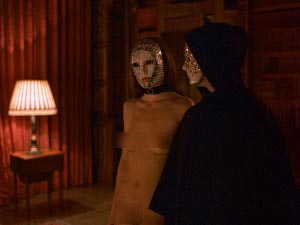 312 |
 313 |
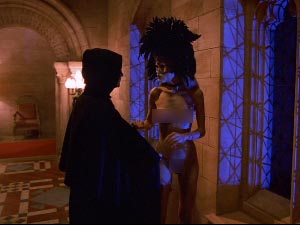 314 |
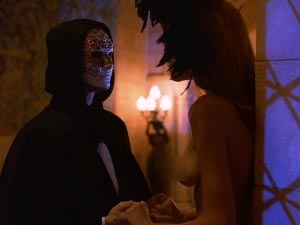 315 |
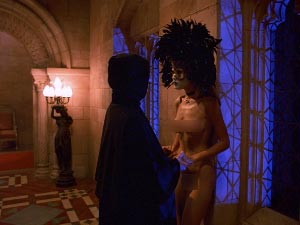 316 |
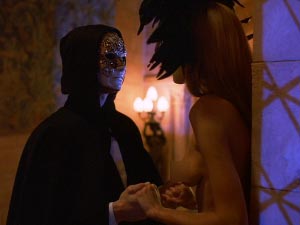 317 |
 318 |
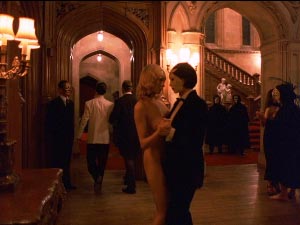 319 |
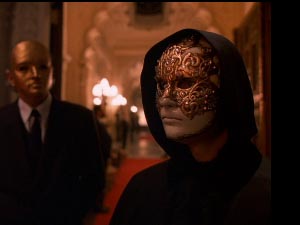 320 |
The manner in which Bill and the black-feathered woman hold hands is reminiscent of Barry's first kiss shared with Lady Lyndon and how they hold hands.
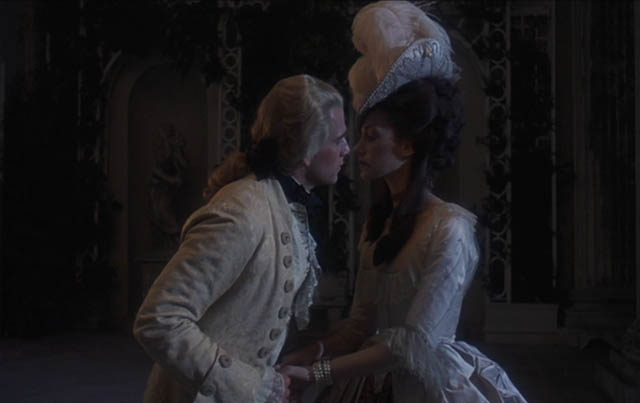
319 LS Nick, still blindfolded, is being led by an attendant from a hall and through a room of couples dancing to Strangers in the Night. In the foreground, a nude man dances with a clothed man. A nude woman dances with a woman wearing a tux. (1:23:55)
320 MS The attendant leading Bill down a mirrored hall. (1:24:09)
This is the same hall that Bill and the Black Feathered Woman had used for exiting the large room in which had been held the ritual with the 11 women. At the end of it, entering the large room, Bill is surprised to find a number of masked individuals standing around in a partial circle staring at him, the Hierophant seated at the center in a throne, an attendant to each side.
The "Strangers in the Night" music had faded as they came down the hall but now abruptly ceases.
321 LS The circle with the Hierophant at the center. (1:24:25)
The sun masked individual to the right stands out prominently, as does the plague doctor in his extended beak.
The two figures in blue that flank the Hierophant will stand out prominently through much of this scene and must be looked upon in respect of how this blue has figured in earlier scenes.
This blue backed Alice through much of their argument.
The blue was in the entry outside Marion's. In fact, twin windows.
Kubrick had Marion consistently seated before a blue window.
Blue dominated the kitchen when Alice called Bill, interrupting his encounter with Domino.
Finally, the blue stood out in the Sonata Jazz club and was consistently behind Nick as he conversed with Bill.
322 MCU The Bauta figure with the woman in the striped mask standing alongside. (1:24:30)
323 MCU Man in a red open mouthed mask to screen right of the Bauta figure. (1:24:32) The expression is as if shock and horror.
This individual in the red mask had been standing opposite the Bauta figure previously, at the end of the opening ritual.
324 MCU Masks. (1:24:35)
A mask closely resembling a human face, mouth open in speech, the eyes black. This is said to be the Mary Magdalene mask, but it appears masculine. Beside this to the left is a person in a black and white mask expressing duality.

325 MCU Masks. (1:24:36)
Most prominent are two individuals in green masks. A person to the right has on a black mask with colored dots on it, as if the bokeh of the Christmas lights we had seen on the streets.
326 MCU Masks. (1:24:39)
A red lunar mask to the right, and a Picasso styled mask with a face broken into triangular and spherical elements representing profile and side view. To the left is a woman in a mask with a purple headdress. She had been one of the first to be seen when Bill arrived.
327 Masks. (1:24:40)
These are masks to the left of the ones we just saw, seemingly, as one of the green masks is to the right. Foremost is a gold mask with perhaps an accusing expression. To the left is a duality mask in red and white. To the far left is a person in a mask showing three faces, one full and two in profile.
328 The circle with the Hierophant. (1:24:43)
The music now playing is Gyorgy Sandor Ligeti's "Musica Ricercata #2", performed by Dominic Harlan. Gyorgy Sandor Ligeti was a Hungarian who moved to Austria. The 10th piece of Musica Ricercata was banned in Hungary as it was considered decadent. Perhaps it is coincidence that in this scene, involving masks (dominos), we have the music performed by a Dominic, the name coming from the same as domino. The composer's middle name, Sandor, is the same as the Hungarian at Victor's party who enticed Alice with Ovid's arts of love (seduction) and an offer to assist her via others in the art game. He had asked if she would like to see the Renaissance (rebirth, renewal) statues on the second floor.
We have cycled back around to the first party in which Bill professed to know no one, he only being invited to the affairs because he made house calls.
Ricercar means "to seek again, seek out".
In a ricecar there is exploration of permutations of a given motif, an idea in keeping with Bill's odyssey which concerns some prime motifs and a journey through permutations of them.
HIEROPHANT: Please, come forward.
329 MS Bill advancing. (1:24:51)
330 LS The circle with the Hierophant. (1:24:59) From Bill's POV, the camera moves into the circle.
 325 |
 326 |
 327 |
 328 |
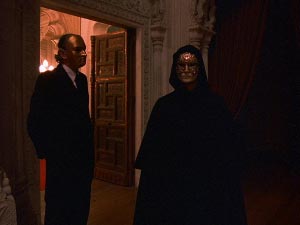 329 |
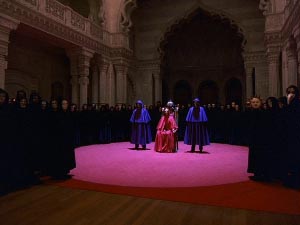 330 |
331 MS Bill advances into the circle. (1:25:04) As he enters it, the circle ominously closes behind him.

332 MS The Hierophant with his attendants. (1:25:17)
HIEROPHANT: May I have the password, please.
333 MS Bill. (1:25:25)
BILL: Fidelio.
334 LS Camera revolves around Hierohpant to the rear, outside the circle. (1:25:29)
HIEROPHANT: That's right. That is the password. For admittance. But may I ask what is the password for the house?
335 MS Bill from without the circle, the camera revolving about it. (1:25:43)
BILL: The password for the house.
HIEROPHANT: Yes?
BILL: I'm sorry, I...
336 LS The Hierophant, attendants and Bill viewed from without the circle. (1:26:04)
BILL: I...I seem to have forgotten it.
A general commotion passes about the room between the attendants.
HIEROPHANT: That's unfortunate. Because here, it doesn't matter whether you have forgotten it, or if you never knew it.
337 MS The Hierophant. (1:26:27)
HIEROPHANT: You will kindly remove your mask.
 332 |
 333 |
 334 |
 335 |
 336 |
 337 |
338 MS Bill. (1:26:32)
Bill takes down his hood and removes his mask. We see, to the right, an individual wearing a mask that could possibly be a stylized version of Bill's face. He had been standing to the left, where the circle separated, when Bill was returned to this area.
When Bill got the phone call that Nathanson had died, his remark to Alice had been he would have to go over there and show his face. Now he has.
Bill is clearly shaken.
339 MS The Hierophant. (1:26:52) The camera continues its slow revolutions.
HIEROPHANT: Now, get undressed.
340 MS Bill. (1:26:57)
BILL: Get undressed?
341 MS The Hierophant. (1:27:07)
HIEROPHANT: Remove your clothes.
342 MS Bill from rear right, the camera continuing its revolutions. (1:27:10)
Bill looks to the right.
343 MS The Bauta figure and the woman in the striped mask. (1:27:16)
It seems he has looked for help to the man who had earlier nodded at him.
344 MS Bill. (1:27:20)
BILL: Gentlemen, please. Uh...
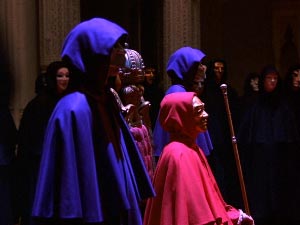 339 |
 340 |
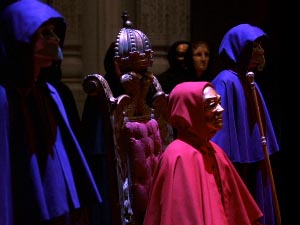 341 |
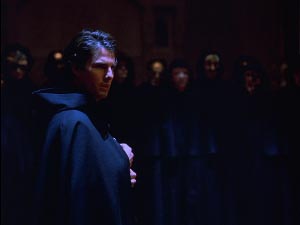 342 |
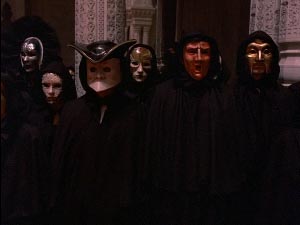 343 |
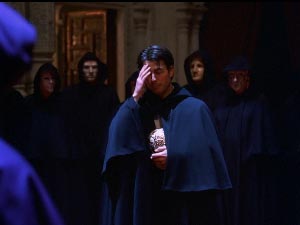 344 |
345 MS The Hierophant. (1:27:28)
HIEROPHANT: Remove your clothes. Or would you like us to do it for you?
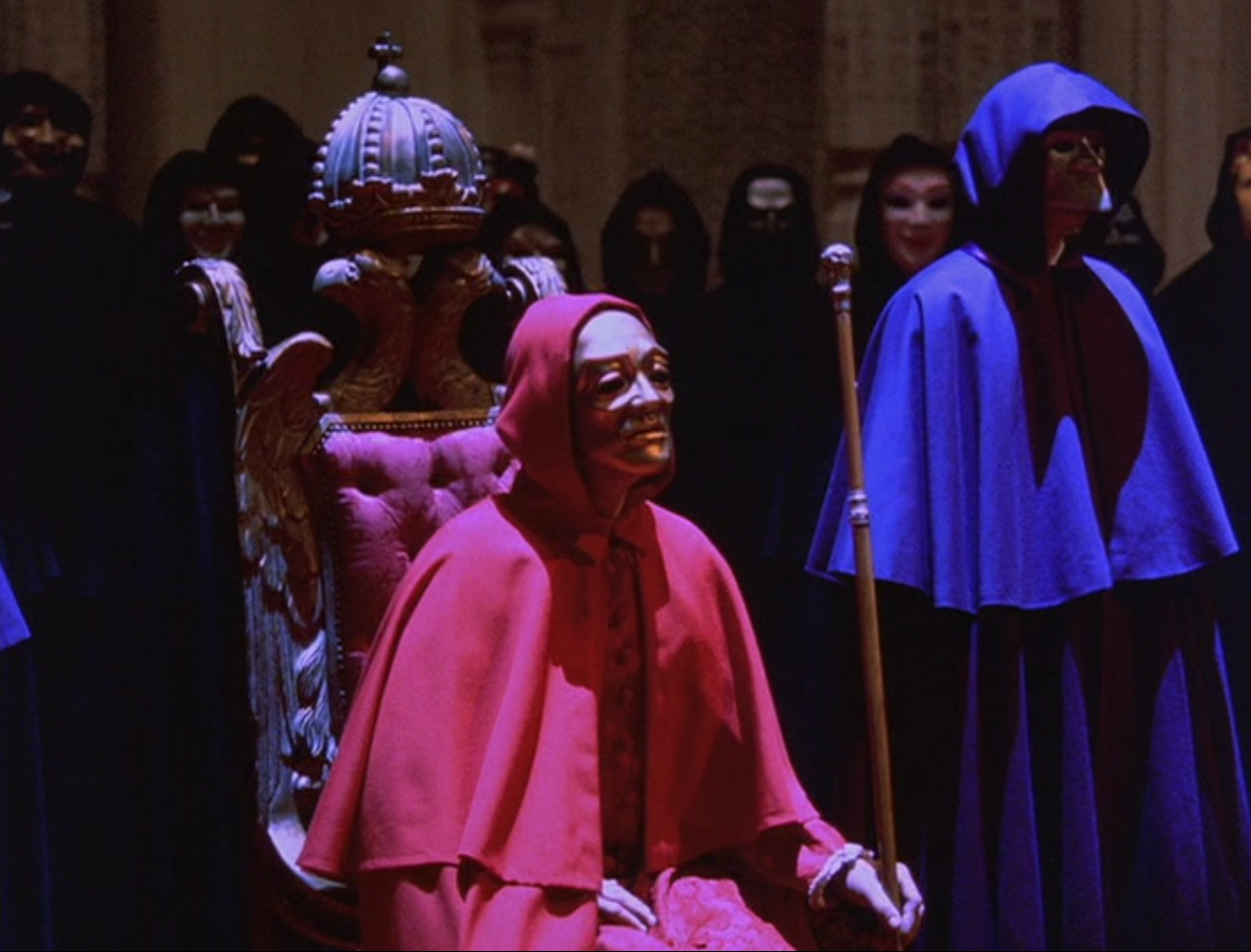
John Bourassa at gotfromnaught.blogspot.ca made an interesting observation concerning Red Cloak's mask. He wrote to me proposing it was representative of Peter Lorre, or a mask Peter Lorre wears in the film, "The Face Behind the Mask", made in 1941. Lorre plays Janos Szabo, an immigrant to America who falls upon hard luck, is in a fire, and his face is so disfigured that he is unable afterward to earn a living. He nearly commits suicide due it, but instead enters a life of crime. His hope is to have plastic surgery. He finds out this is impossible and takes up wearing a prosthetic mask. Eventually, he falls in love with a blind girl who reminds him of who he is and the life he'd like to live. Things don't end happily for them.
Bourassa also posits a connection to a publicity still of Lorre in The Maltese Falcon. He then makes a good case for comparing the two falcons, the fake one switched for the real one, with the problem/predicament of the woman at the orgy being not Julienne Davis, who played Amanda. Having brought up the two falcons, he then refers to the double-headed falcon on Red Cloak's throne, and discusses its history some and its representing both the secular and the sacred as concerning the dual nature of power.
346 LS The Black Feather Woman standing in a second floor archway. (1:27:35) The camera zooms in on her.
BLACK FEATHER WOMAN: Stop!
347 MS Bill turning to look at her. (1:27:38)
A gasp arises all around, everyone turning to face her.
 346 |
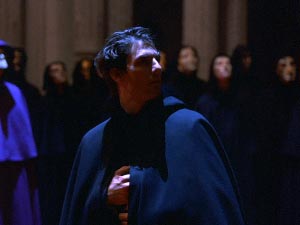 347 |
348 MS Black Feather Woman. (1:27:42)
The woman in the black feathered headdress appears, dramatically lit from behind, on the second floor and demands that Bill be let go, that they should take her, she is ready to redeem him. The style of lighting signifies this is certainly not impromptu. This is a self-sacrificial savior scenario, the woman becoming a Christ figure with her offer to exchange her life for his, or as much is implied.
The manner in which she is framed by her feather headdress reminds of the women in the paintings in Dick's home in The Shining.
 There is also perhaps a precursor in the film, back at the Rainbow, the Japanese man hiding in the "closet" with the curly black halo wig, wearing only a thong, overlaid with the reflection of the male Flamenco dancer.
There is also perhaps a precursor in the film, back at the Rainbow, the Japanese man hiding in the "closet" with the curly black halo wig, wearing only a thong, overlaid with the reflection of the male Flamenco dancer.
The Black Feather Woman has not simply appeared here. She is back lit. Theatrically staged.
This is the last of the many interruptions that Bill experiences. His interruption when talking with Nick at the party, the interruption with Nuala and Gayle, the interruption of Lou Nathanson dying, the interruption of Carl arriving at the Nathanson's, the interruption of Alice calling him at Domino's, the phone call that interrupted his conversation with Nick at the Sonata, the sound at the Rainbow that interrupted his renting the cloak, the interruption when the black-feathered woman was taken upstairs, the interruption when he was told the driver of his taxi was wanting to speak to him.
BLACK FEATHER WOMAN: Let...him...go!
349 LS from above, the Hierophant and all in the circle looking up at the woman. (1:27:46)
BLACK FEATHER WOMAN: Take me!
350 MS Bill with the Hierophant behind. (1:27:50)
BLACK FEATHER WOMAN: I am ready to redeem him.
The camera continuing to revolve outside the circle, we immediately have an extreme close up of the blue mask that had been earlier seen behind Bill. Though not a fade to black, as with the transition shots from Alice and Bill kissing before the mirror in their bedroom, or the fade to black shot that again occurs in the Harford bedroom after Alice has related to Bill her dream, the extreme close-up here of this particular mask, after the Black Feather Woman has announced she's ready to redeem Bill, shares a certain resonance with those fade-outs.
The commotion rises. The Hierophant stands.
HIEROPHANT: You...are ready to redeem him?
BLACK FEATHER WOMAN: Yes!
351 MS Profile of the Hierophant. (1:28:11)
HIEROPHANT: Are you sure you understand what you're taking upon yourself in doing this?
352 MS BLack Feather Woman. (1:28:17)
BLACK FEATHER WOMAN: Yes.
353 LS from above of the circle, Bill and Hierophant all looking up at the woman. (1:28:20)
More commotion among the guests.
354 MCU Hierophant. (1:28:24)
HIEROPHANT: Very well.
355 MS Bill. (1:28:28)
HIEROPHANT: You are free.
356 MS Hierophant. (1:28:37)
HIEROPHANT (to Bill): But I warn you, if you make any further inquiries, or if you say a single word to anyone...
357 MS Bill. (1:28:45)
HIEROPHANT: ...about what you have seen, there will be the most dire consequences for you and your family. Do you understand?
Bill nods his head and turns to look up at the woman.
358 LS The Black Feather Woman. (1:29:11)
A man in a plague doctor mask enters from the right to take her arm and leads her away.
Considering that Bill is a doctor, it says something about the situation that it is a plague doctor who would lead the woman away, the infiltrating Bill cast as the responsible party.
359 MS Bill. (1:29:29)
BILL: But...what is going to happen to that woman?
360 MS Hierophant. (1:29:44)
HIEROPHANT: No one can change her fate now.
361 MCU Bill. (1:29:46)
HIEROPHANT: When a promise has been made here, there is no turning back. Go!
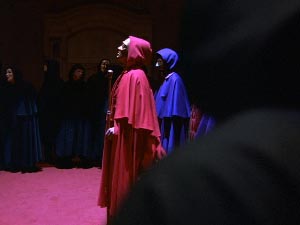 351 |
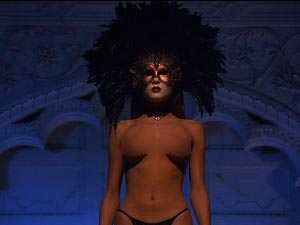 352 |
 353 |
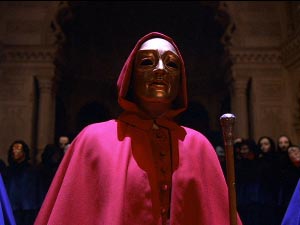 354 |
 355 |
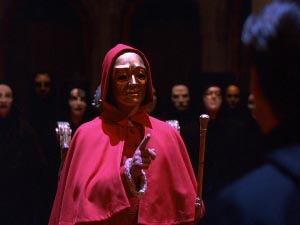 356 |
 357 |
 358 |
 359 |
 360 |
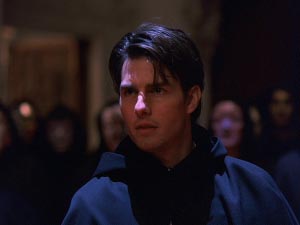 361 |
|
Beethoven's Fidelio was originally named "Leonore, oder Der Triumph der ehelichen Liebe", which in English is "Leonore, or The Triumph of Marital Love". The plot concerns a woman, Lenore, who masks herself as a man, Fidelio, thereby gaining access to a prison in which her husband, Florestan, is being held. Without going into the somewhat convoluted plot, she saves his life there, just before justice has its victory and Florestan is released.
The Teatro alla Scala describes the opera thusly, "Fidelio is a moral title, associated with the ideals of liberty of the French Enlightenment. Nobility and commoners are united in their thirst for justice against the oppression of power. For once the faithful consort of a desaparecido wins her battle against a treacherous tyrant, and the collective joy truly is “nameless”, as is sung on the stage. Especially because the “our heroes to the rescue” finale is recounted by the triumphant symphonic flair of the quintessential musician. Beethoven really does bring the world to collapse at the conclusion of this opera, which begins like a delightful little comedy, but which scales and transcends all the summits of the dramatic-musical art."
If we look back on the scene at the Rainbow, we will remember the two men who were locked in the Rainbow's office, and that it was said the police would be called on them, but this doesn't happen, they are freed. Just as Bill here is freed through the redeeming action of the Black Feather Woman.
The Shining opens with "Dies Irae", which as to do with the Day of Judgment and the subject of redemption, and the film is greatly concerned with this.
A Clockwork Orange opens with the "Funeral Music for Queen Mary", which again is concerned with redemption.
Spare Thy people
whom Thou hast redeemed
with Thy most precious blood,
and be not angry with us for ever.
Spare us, good Lord.
Ideas of redemption and sacrifice are not at all peculiar to Eyes Wide Shut for they appear throughout Kubrick's work. Rather than rephrasing, I'm quoting the below directly from my analysis of The Shining, because it's just more expedient to do so.
In Rememberance and Repetition in Kubrick's "The Shining" I propose a meaning for the curious CRM-114 that is found in different formations in Kubrick's films. In Doctor Strangelove the CRM 114 radio equipment of a military jet is damaged so that it is unable to receive a recall code that would stop it from continuing its mission to drop a nuclear warhead on Russia. In A Clockwork Orange Alex is separated out to be given the treatment that will make him into the "perfect Christian", which involves the injection of Serum-114. When Alex is told he's lucky to have been chosen, as the word "chosen" is said the camera zooms in on Serum 114. Because of this, I have reasoned it is likely that CRM and Serum are a variation of the Hebrew word ChRM, which means "chosen", secluded, devoted to religious purposes.
ChRM (herem) is a peculiar word and there's some debate on its exact meaning. Often it is used for things purposed for destruction--not as a matter of personal vendetta but as a dedication to god as commanded by god, as in a ritualized killing, that thing or person thus marked apart as belonging to god.
Rabbi Howard Cohen writes of "herem":
The second half of Leviticus 27:28 states that "...every proscribed thing is totally consecrated (alternatively, is considered to be super holy) to the Lord". Since something that is "tamei" (ritually unclean) must be set aside, that is put into a kind of temporary "herem", for varying lengths of time and must not come into contact with things or people who are deemed "tahor" (ritually clean) or "kadosh" (holy) it is hard to understand why the Torah describes something proscribed as also super holy ("kodesh-kodeshim"). Moreover, both "herem" and "kodosh" have essentially the same meaning: something set aside for specific purposes associated with the temple, property (so to speak) of God. How is it that something which is "herem"- proscribed can also be "kodesh-kodeshim - holiest of holies? Rabbi David Kraemer offers a brilliant insight into understanding this problem. Both "herem" and "kadosh" mean set aside for God. The difference, Kraemer argues, is that things which are proscribed are completely cut off from human access while things which are 'kodesh' have limited access. In other words, "herem" is like "kodosh" only more so, hence the reason why Leviticus 27:28 conflates "herem" with "kodosh-kodeshim".
So we have positive as well as negative applications.
It's familiar through the many Arabic words formed on it, which have in them the idea of something taboo or forbidden, or holy. The sacred black stone Kaaba resides in the holy house built around it, Masjid al-Haram. Haram can mean an inviolate zone as in a sanctuary, or something which is impure, forbidden.
Keeping in mind the above several paragraphs, a different light may be shed on the many notices at the hotel emphasizing cleanliness, using the appropriate bins for litter, and Wendy's game with Danny as they ran into the maze, she saying the loser would get the job of keeping America clean, the litter bins about the grounds of the hotel decorated with "Keep America Clean" posters.
In Eyes Wide Shut CRM 114 is supposedly formed by appearing as the C-Wing, room 14, the morgue where Bill sees Amanda's body--and we have again the idea of separated out as she had offered to redeem him at the party.
Going to Leviticus 27 we see:
Notwithstanding, no devoted thing, that a man may devote unto the Lord of all that he hath, whether of man or beast, or of the field of his possession, shall be sold or redeemed; every devoted thing is most holy unto the Lord. None devoted, that may be devoted of men, shall be ransomed; he shall surely be put to death.
Thus we have Bill asking, "How is this woman to redeem me...I can't let this woman pay for me." And the answer being he can't change her fate, that when a promise has been made there is no turning back.
No turning back. For me, that this happens in shot 361 is significant as it takes us beyond the 360 degrees of a circle, as if an expression of having moved beyond the point of being able to turn back.
Back at the Rainbow, the teen girl's father had promised to kill her. Now, does the teen girl end up dead? No, she doesn't and she doesn't look at all distressed by her father's "promise" to kill her. Bill returns the next day and is confused to find the Japanese men leaving and the father saying that he hadn't called the police as they had come to another arrangement. Does the black feather woman at Somerton end up dead? Yes, but the film leaves it up to the audience to determine if she was killed or died accidentally. It is the key mystery of the narrative if it is accepted as naturalistic. Was she killed or did she OD? Victor attests, "She was a junky. She OD'd....It was always going to be just a matter of time with her. Remember, you told her so yourself." As Kubrick's films, every single one, are all about predestination versus free will, my personal take is that we are dealing with fate. The kind of mechanical clockwork fate explored in A Clockwork Orange. The same kind of fate that determined Bill would end up at Somerton as both an intruder and an invited guest, for as we see he steps into a privileged spotlight upon his arrival. One way to read this is, in his bringing Amanda back perhaps from the brink of death, Bill is, in the film, given as having violated a kind of taboo area, stepping upon fate's toes. As Orpheus with Eurydice, he attempts to rescue her. He calls her back. Beckons her to respond to his voice. Must Amanda die? It seems that after his seeming rescue of her that he finds himself in situations that could place the future of his life as he's known it in jeopardy. Bill's travel to Somerton takes him into a kind of underworld away from New York, the last building we see before he reaches Somerton being a mortuary. He visits the mysterious line between life and death and rebirth, between the wilfull dreams and hopes of men and women and the clockwork oracle. As a doctor, he has tried to rescue Amanda, and in so doing has trespassed in the land of the dead. A peculiar, even spiritual bond having been established with Amanda after rescuing her, she offers to complete the death process, to fulfill fate, freeing him.
But Amanda is herself a response to Alice's plea that Bill no longer sees her. We are not dealing with people and personalities but something deeper.
ALICE'S DREAM
ANOTHER CHANGE OF LOCATION OF PAINTINGS - DIFFERENCES BETWEEN ALICE'S DREAM IN THE SCREENPLAY AND THE FILM - AN EXAMINATION OF ALICE'S DREAM IN THE SCREENPLAY AND HOW IT RELATES TO THE FILM - THE SHEKINAH AND THE DESIRE TO UNITY - ON THE GARDEN OF EDEN, NOAH, DIONYSUS AND THE NAVAL OFFICER - CARNIVAL AND THE FLOOD -THE STATE OF AFFAIRS AS BILL BEGINS THE NEXT PHASE OF HIS JOURNEY
362 MS Entryway of the Harford's apartment, Bill entering. 1:29:58)
Next we see Bill entering his home (5A on the door), carrying the bag in which is his costume. We see through the door that the blue hall outside is decorated with fleur-de-lis, as did we see the fleur-de-lis in Marion Nathanson's home. To the right, inside the door, are two paintings we have previously viewed in the mirror of the vanity in the bedroom, displayed now here together. A lamp in a hall beyond is the same as a lamp in his bedroom.
Quietly, he locks the door. As to the paintings we see to the door's right, they were in the bedroom originally. The bottom painting, of the green arch, was in the movie's opening hanging outside the dressing room, reflected in the mirror above the dresser from which Bill took his white handkerchief. Later, after the party, when Alice and Bill were standing before the mirror over the vanity beside the dresser, we could see the reflection of where the painting should have been and it was changed out to be the painting now hanging here above the painting of the green arch.
If we adjust the shadows and highlights we get a better glimpse of a light that crosses over Bill's back for an instant.
Someone had mentioned this light in the comments when I had the analysis on my blog. I had observed this light before, which does look like an eye, but had opted to not get into it in the analysis. But I may as well throw it in here. Bill is carrying a Rainbow bag, and as I noted in Part one, the Hebrew for the rainbow is QShTh, a bow (for shooting, strength), and is also the iris of the eye. The eye is itself, ONH (the Hebrew letter O signifying the eye), while the cloud in which the bow is set is ONN.
We have also just seen outside the door the fleur-de-lis pattern on the wallpaper, the fleur-de-lis being also an iris, and Iris being a goddess of the rainbow, transmitting messages from the gods to mortals.
One could certainly look upon the eye on Bill's back as representing he is now being followed and all his actions known. There are a number of ways one can look upon it.
We've seen eyeball-like motifs earlier in the film. When Alice and Bill entered Victor's party, there was what one could look at as being an eyeball motif in the floor tile behind them. When Bill entered his office from his elevator we had the same in the painting observed in the elevator.
Bill now goes to the hall to the left first to check on Helena, passing the "Flowering Hawthorn and Bracken" painting I described earlier. Haw coming from "hag", connected with "hedge", the hawthorn can be said to be connected with borderline areas, "because the hedge was the boundary between the civilized world of the village and the wild world beyond", so says etymonline. So it is a suitable painting to focus upon as Bill returns from Somerton.
363 MS Helena asleep in her bed. (1:30:32)
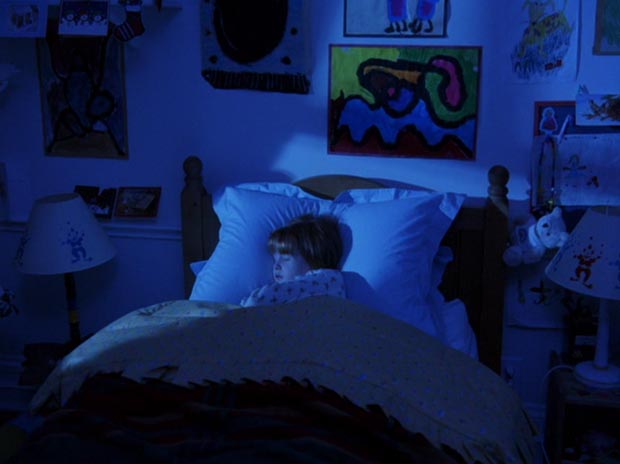
364 MS Bill in Helena's doorway. (1:30:36)
He goes back through the hall to the living room where the Christmas tree is still lit.
Off the living room to the screen right of the fireplace is his office. He enters it. This view of the office is quite different than what we saw when Alice had asked him if he wanted to wrap presents earlier in the night. There is now a credenza where before there had been an easy chair. He unlocks a cabinet, and conceals the Rainbow bag in it, removing an expandable file from the cabinet in order to do so.
With the expandable file we have a reference to The Killing. In that film, the morning of the robbery at the racetrack, Johnny goes to a luggage shop, located next to a maternity shop, and purchases a briefcase. He hides in it a duffle bag and a mask. After he's let into the back area of the racetrack clubhouse, he goes to the empty employee's locker room. He puts on the mask. The duffle bag? He uses that for the loot he steals. The rigid briefcase isn't expandable, the duffle bag is. The maternity shop comments on this expansion and contraction, like a pregnancy. Trust me on this. We have a joke based on this in The Shining. A small VW delivers Jack and his family to the Overlook, yet when we see the luggage they've carried up with them it's too much for even a station wagon. No VW could carry it. It's a reference back to the duffle bag hidden in the briefcase, the concealed duffle being able to hold a lot whereas the briefcase can't.
If we refer to Schnitzler's book, to which Kubrick acquired rights somewhere around 1970 or so, I've read differing dates, in the dream that Albertine relates to Fridolin, he goes about acquiring jewels and fine clothing for her, putting them in a yellow bag that expands so that it can hold everything. One might think that this expandable file folder then comes only from the book, just as it seems that the yellow VW that holds far more than it possibly could connects to this yellow bag. And it does. But already in 1956 in The Killing Kubrick has the expandable duffle bag. Had he by then read Schnitzler's novel but didn't acquire the rights until much later? Or is the idea already present and Kubrick found in the novel a parallel which he tied in with the duffle, brought in the yellow color for The Shining and now has the expandable file. I suspect the latter.
365 MS The bedroom, Alice asleep. (1:31:41 crossfade begins and ends at 1:31:43)
View from the direction of the bathroom, Alice asleep in her bed, Bill entering the doorway of the bedroom. We see beyond the dressing room and the two black bags leaning in the left corner. We also seem to see the two tennis rackets that had been there when Alice was dressing. It seems that what had been initially expressed as different dressing rooms, in the same place, that looked almost the same but not quite, have been now integrated after the visit to Somerton.
Alice, asleep, begins to laugh or panic in her sleep, it's hard to tell which, but seems at first to be laughter.
BILL: Alice? (Shakes her.) Alice?
Alice starts up in a panic.
It is a riveting piece of acting and Nicole Kidman addresses it in a film on Kubrick, saying that she wasn't sure what he wanted and did the scene several times with his coaching until he got what he was looking for.
The manner in which her mouth is spread in a tooth-baring grimace/laugh, reminds me a good deal of the mask at Somerton that was based on a Mary Magdalene mask, for it is supposed to be portraying horror over the death of Christ, yet in some angles resembles more a laugh. As we shall see, the association with Mary Magdalene may bear out via a portion of Alice's dream that was in the screenplay but did not make it into the film.
BILL: It's okay. It's okay. I'm sorry. I'm sorry I woke you up but I thought you were having a nightmare.
ALICE: Oh god. I just had such a horrible dream. What time is it?
BILL: It's a little after four.
ALICE: Did you just get home?
BILL (removing his shoes): Yes. It took longer...longer than I thought.
ALICE: You must be exhausted. Come on. Lie down. Lie down.
She pulls him to lie down beside her and strokes his head.
366 MS Bill and Alice from the right side of the bed. (1:32:52)
BILL: What were you dreaming?
ALICE: It was just, uh, just these weird things.
BILL: What was it?
ALICE: Oh, so weird.
BILL: Tell me.
The manner in which Bill asks about her nightmare, after having lying to her about where he has been, gives us the feeling that Bill knows Alice's dream will have had to do with his actions that evening.
ALICE (sitting up): Oh. We were...we were in a deserted city and uh our clothes were gone.
Music begins.
ALICE: We were naked. And I was terrified. (She begins to cry.) And I...
367 MCU Bill. (1:34:04))
ALICE: ...and I felt ashamed. Oh, god.
368 MS Alice. (1:34:10)
ALICE: And, and I was angry because I thought it was your fault. You...you rushed away to go find clothes for us. As soon as you were gone it was completely different. I...I felt wonderful. Then I was lying in a beautiful garden, stretched out naked in the sunlight, and a man walked out of the woods. He was the man from the hotel, the one I told you about, the Naval officer. He, he stared at me and then he just laughed. He just laughed at me.
Alice lies back down and sobs. Bill sits up.
Shot 267, as Bill nears Somerton, is a crossfade with Bill emerging from the woods. I'm supposing that Bill being pictured as emerging from the woods is an intentional anticipation of the man in Alice's dream stepping from the woods.
369 MS Bill sitting up. (1:35:40)
BILL: That's not the end, is it?
ALICE: No.
370 MCU Bill. (1:35:59)
BILL: Why don't you tell me the rest of it.
371 MS Alice. (1:36:02)
ALICE: No, it's too awful.
372 MCU Bill. (1:36:10)
BILL: But it's only a dream.
373 MS Alice. (1:36:14)
Alice sits up and holds Bill to her.
374 CU Bill from behind Alice. (1:36:20)
ALICE: He, uh, he was kissing me. And then...
375 MS Alice and Bill in their embrace. (1:36:46)
ALICE: ...then we were making love. Then there were all these other people around us, hundreds of them everywhere, everyone was fucking. And... (She cries.) And then I...I was fucking other men. So many, I...I don't know how many I was with.
376 CU Bill from behind Alice. (1:37:22)
ALICE: And...
377 MS Alice and Bill in their embrace. (1:37:27)
ALICE: ...and I knew you could see me, in the arms of all these men, just...just fucking all these men.
378 CU Bill from behind Alice. (1:37:39)
ALICE: And I, I wanted to make fun of you, to laugh in your face. And so I laughed as loud as I could.
 366 |
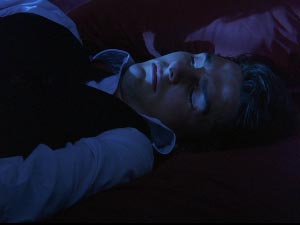 367 |
 368 |
 369 |
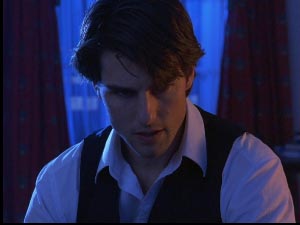 370 |
 371 |
 372 |
 373 |
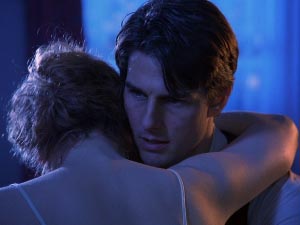 374 |
 375 |
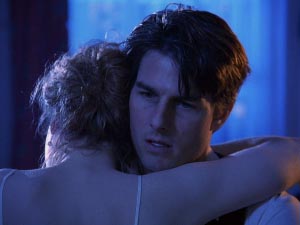 376 |
 377 |
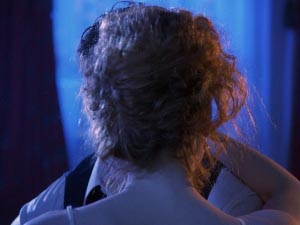 378 |
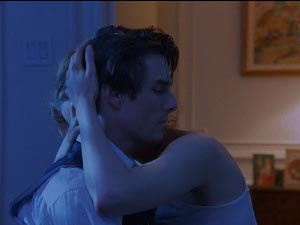 379 |
379 MS Alice and Bill from the side, she having pulled away from him. (1:38:07)
ALICE: Oh, that must have been when you woke me up.
Crying she embraces him again. We see his profile as we have a fade into black of the same type that ended shot 56 when Alice was looking in the mirror as Bill kissed her after Victor's party, as the Chris Isaak song played.
Chris Isaak. Alice has just mentioned that it was when she was laughing at him that Bill most have woken her up. In the scene in which Alice and Bill argue and she begins laughing at him when he says he is sure she would never be unfaithful to him, she begins to laugh, and I had made a passing mention that Chris Isaak's last name means laughter. Now, here, Alice speaks of her laughing in her dream and being woken up by Bill, and Kubrick punctuates this with the same type shot he had used while the Chris Isaak music played. So, I don't think I'm off the mark in having made that connection.
Isaac was the child that God demanded Abraham bind and sacrifice, who was replaced by a ram, but there are varying accounts of this. I brought up this myth earlier due its similarity to the sacrifice of Iphigenia, a daughter of Clytemnestra, sister of Helen, sometimes instead given as a daughter of Helen and Theseus, who defeated the minotaur in the labyrinth. I mentioned also the resemblance to the story of Jephthah's sacrifice, though she may instead have been separated from the secular world for service in the temple. Regardless, in all these instances a terrible demand is made by a terrifying God, or a promise to God to give something near and dear is made, in exchange for some favor, or to appease the deity, which tragically turns out to be a child. In Isaac's case, he had asked for a child with Sarah, and having received that child he was then told to sacrifice, to give him up. I have written of this in connection with The Shining as well, for I believe it's referred to in that film, and certainly we can see it in the demand being made of Jack to do something about Danny and Jack believes it means to kill him, and promises to take care of the problem.
Bill's family is also in jeapordy here, he having been told that they will face dire consequences if he makes further inquiries or says a single word to anyone. But we also mustn't overlook that the sacrifice of Isaac was played out in Alice's being willing to sacrifice everything, even her child, for one night with the naval officer.
Bill, despite the warning, despite the threat made against his family, will audaciously pursue inquiries the following day.
The movie cut much of the dream that was presented in the original screenplay.
I think it started in my parents house. They weren't there. I was alone. That surprised me because our wedding was the next day and I didn't have a wedding dress. Then you and I were floating above a ancient city. It was a kind of crazy mix of ancient architectural styles. Oriental, Egyptian, Greek and Roman architecture. And it was completely deserted. The streets were empty--no people, no animals. And I remember thinking, so this is our honeymoon. Then it was night and the sky was so full of stars, and so blue and wide it seemed like it was painted. You said it was the ceiling of our bridal chamber and you took me in your arms and made love to me and said you would love me forever...We made love and it was wonderful, though there was a sadness to it, and a presentment of sorrow.
Suddenly it was morning and we were somewhere in the strange city. We were still completely alone. But something terrible had happened--our clothes were gone. I was terrified as I had never been before, and felt such a burning shame that it almost consumed me. At the same time I was furious with you because I thought it was your fault. And this sensation of terror, shame and fury was more intense than any emotion I had ever felt before. You felt guilty and rushed away naked, to go and get clothes for us.
As soon as you were gone I felt wonderful. I neither felt sorry for you, or worried about you. It was heavenly to be alone. I was lying in a lush garden, stretched out naked in the sunlight, and I was far more beautiful than I ever was in reality. And while I lay there, a young man walked out of the woods. He was the young Naval officer I told you about from the hotel. He looked different but I knew it was him. He stopped in front of me and looked at me searchingly. I laughed seductively and wantonly, as I have never laughed in my life, and he held out his arms to me and sank down beside me...
He looked at me...and slowly took me in his arms...and we began making love. I seemed to live through countless days and nights--there was neither time nor space. And the more we made love the more our hunger for each other increased. And just as that earlier feeling of terror and shame went beyond anything I had ever felt, so nothing can be compared with the freedom and happiness and the...desire that I now felt. Then I realized there were other couples around us--hundreds of them, and they too were making love. Then I was making love to the other men, and as soon as my longing was satisfied with one, I wanted another. I can't say how many I was with. And yet I didn't for one moment forget you. And all this time, you were buying the most beautiful clothes and jewelry you could find for me.
Then you were being followed by a crowd of people who were shouting threats. Then you were seized by soldiers, and there were also priests among them. Somebody, a gigantic person, tied your hands. You were still naked. I knew you were going to be crucified but I felt no sympathy for you. I still blamed you for everything that had happened. I felt that I was far removed from you but I knew you could see me naked in the arms of countless men in this sea of nakedness which foamed around me. The soldiers began to whip you and blood flowed down you in streams. I saw it without feeling any surprise or pity. Then you smiled at me as if to show you had fulfilled my wish and bought me everything I wanted. But I thought your actions were ridiculous and I wanted to make fun of you, to laugh in your face. They began to nail you to the cross and I hoped that you would be able to hear my laughter. And so I laughed as shrill and loud as I could. That must have been the laugh that you heard when I woke up.
The laughter. Alice is describing the Mary Magdalene mask at Somerton based on Niccolo dell'Arca's "Lamentation of Christ", but looks instead like it could be laughing rather than screaming in horror. I had stated that I felt the name Niccolo would lead back to Alice (Nicole). Mary Magdalene, the prostitute.

The earlier screenplay has Bill hearing Alice's dream and bitterly thinking of her as being a whore, as does Fridolin in the book become upset with his wife when he hears of her sexual fantasies and has difficulty with them, thinking of her, too, as wanton, a whore.
I don't think Kubrick is intending to communicate that about Alice--or should I say that I don't think he intends to communicate this is how Bill thinks of Alice.
In The Shining, I do believe Kubrick pulled the veil back on the misogyny of the audience, that they would have for Wendy, so that many were irritated with her for no reason at all, taking on Jack's ire, thinking of her as Jack would. Certainly in this film again we are being confronted with the place of women in society, the misogynistic devaluation of the prostitutes, and Alice's sense of loss of self in being seen only as Mrs. Bill. But the way Bill listens to Alice here, he hears her dream with a sense of knowingness and guilt (over his lying to her and having been at Somerton) and perplexity. Of course, yes, he also hears in it the depth of the connection between her and this mysterious Naval officer, and if anything confounds him about Alice's story of the officer, it is this. But his response here is tempered by his own actions that evening.
It's made obvious from this dream that the film isn't just about a man with a narrow view of women struggling with expanding his mundane view of sexuality. Kubrick has chopped the dream story down from the screenplay, but Alice's monologue would have been too long at this point and would have been a disruption of flow, so with images and music Kubrick has charged the film with mystic subcontext. But it's good that we have the screenplay, too, though Kubrick may have even determined the dream in the screenplay revealed too much.
Alice is in real anguish. She is bewildered by the dream. It wants and acts as she doesn't desire to want and act. It reveals a sensibility alien to her own lurking in the unconscious.
It also invokes, with Mary Magdalene's laughter, a sensibility alien to the Christian concept of her as the penitent prostitute.
We are close here to a version of the mystic marriage, of the Shekinah cleaved from the King, the godhead (of which she is a part), to reside in exile in the base world, the mother of all, and the task being the reunification of her with the En Sof.
The desire is to unity.
When a man sins it is as though he strips the Shekinah of her vestments, and that is why he is punished; and when he carries out the precepts of the law, it is as though he clothes the Shekinah in her vestments.
There are hints of the Garden of Eden in the dream and if you look at the story of Noah it is very much another kind of creation myth, in that it is the ushering in of a new world, just as in the story of the Greek flood, Deucalion and Pyrrha surviving and repopulating the world by throwing stones behind them (the bones of their mother) as they went.
That there is a mix of different kinds of architecture in Alice's dream suggests perhaps we've a drawing upon a variety of mystic traditions in the story. That it begins with a blissful wedding, then with their waking, Alice feeling a terrifying shame, Bill running off to get clothes for her, is very like a Garden of Eden scenario in which Adam and Eve, separated from the godhead, living with Shekinah in the material world, received garments of animal skin, or the physical body.
To complicate matters, there is a Dark Shekinah who is sometimes linked to Lilith, the first wife of Adam.
Alice and Bill's apartment is thus filled with references to the garden and the fruits plucked from the tree, those fruits perhaps representing also the separation of the Shekinah and mankind.
ORV is to be naked, the type of nakedness experienced in the Garden of Eden, Adam and Eve not being ashamed until they ate the fruit of knowledge. That which is given as the snake (whose name means also learning by experience, prognostication) was the most cunning (HIH ORVM) of all life. So he tells the woman if she eats that are eyes will be opened (PhQCh) and she will know good and evil. PhQCh is to be observant. So Adam and Eve ate and their eyes were opened, the word for eyes meaning also fountains, and they knew they were naked. Whereas ORV is the word for naked, OVR is the word for skin. Another form of OVR means to blind, as in having a film over the eyes. The eyelids. I've covered this a little before.
That they see nothing of flesh, prior to Bill running to look for clothes for Alice, reminds of carnival and its meaning to do with the end of flesh, as well as the flood, in which god declared there would be an end to flesh. Thus the deserted city. In the book, the season in which these events occur is Shrovetide, Carnival ("taking away of flesh" carne levare), shrovetide coming from "shrive" which means to confess. Thus the talks that Alice and Bill have with one another suit the time of year in its religious sense.
Alice blames Bill for their fall from grace in the dream. There is something that has alienated them from their garden, she doesn't know what, but blames him.
Bill goes running off to find clothes for Alice, all that he does seeming as an effort finally to win her back, even to the point of self sacrifice, a self sacrifice she appears to demand. In the meanwhile, however, the naval officer had appeared, their eyes meet, he looks searchingly at her, this point is made, and Alice is filled with a great desire and making love with him enters a sense of eternity, timelessness. As they made love suddenly there appeared more and more people making love. In the story of Noah, the dove that flew out of the ark is IVNH, a word that carries in it the idea of warmth, as from their mating, and is from IIN, which is the fermentation of wine and is also intoxication. Then the injunction comes after that the earth should be replenished.
Noah was also a version of a "new wine sailor" and linked to Dionysus.
Finally, we move into the curious scene of Bill's self sacrifice and bloodshed, establishing him as a Christ figure in Alice's dream.
A further injunction given Noah concerned blood:
But flesh with the life thereof, which is the blood thereof, shall ye not eat. And surely your blood of your lives will I require; at the hand of every beast will I require it, and at the hand of man; at the hand of every man's brother will I require the life of man. Whoso sheddeth man's blood, by man shall his blood be shed: for in the image of God made he man.
With the separation of the Shekinah, the bride from the bridegroom (the bridegroom operating here in the dream as Bill attempting to win back Alice), Bill eventually becomes as a Christ in the dream. He has tried to accumulate everything for Alice she might desire, and finally will give his blood, but Mary Magdalene, the prostitute, laughs at the sacrifice as absurd.
Alice was surprised to find in the dream she felt wonderful without Bill. Something horrible had happened but she didn't know what, and with him she felt terror, shame, guilt. When he removed himself these feelings left her and ecstacy returned.
The waking Alice is horrified by the sleeping Alice. The sleeping Alice is laughing even as the waking Alice is crying out in horror, which made for the complexity of emotion Kubrick was reaching for in Nicole in acting the part.
One is perhaps reminded of Bill's telling Alice he had never been jealous of her as she was the mother of his child, his wife, and he knew she would never be unfaithful to him. To which she laughed at his confidence, then related her story of how she'd been immediately willing to give up everything for a man she didn't even know, but this sacrifice wasn't required of her as the man had left.
Fidelio. He knew she would never be unfaithful. She was as Beethoven's Fidelio.
Bill certainly recognizes that Alice's dream contains elements of the party from which he'd just been ejected. "But that's not the end," he'd said, reminded he had been invited to where the rainbow ends.
If the movie was primarily about some secret and elite level of society hosting orgies (and this party and Alice's dream of it are the hub of the movie) then there'd really be no reason for this drawn out odyssey-like exploration of the confusion of love and sex and Alice's dream replaying of this version of the party on an unconscious level, an Alice through the Looking Glass, down the Rabbit Hole adventure exploring a possible hidden reality which is here being expressed in the allegory of the masked orgy, where, as some audience members complain, no one seems to be much enjoying themselves.
The music at Victor's first party is all about eternal love, the ultimate unity of one person joined with another, even while Bill flirts with the models, Alice with Sandor, and Victor is caught with Amanda upstairs. Bill, as presented at the beginning of the film, seems a person highly unlikely to go through this fundamental a crisis over his wife fantasizing an affair with a naval officer. There's no reason for her confession to push him into the night and into the arms of a prostitute and finally to this curious party. The mystery with which he's dealing is broader, though examining the relationship between love and sex has its place in his crisis. He has been propelled into an initiation drama with its attending revelations that shock one out of mundane complacency into considering deeper aspects of life, but that initiation drama is no more shocking and strange than what happens when any individual finds themselves unbound by the cultural map that has informed them, since the day of their birth, as to who they are, what their place in the world is and how everything fits together.
The audience's experience is as Bill's. At this point, Bill believes he knows what has happened, he just doesn't know who the woman at the party was and what happened to her. His odyssey is not over yet. Next, the film will continue with seemingly building up a story in which Bill can believe, one based on his assumptions and experience, then breaking it down so he knows little more than when he began. As with events in The Shining, the audience is presented the puzzle of determining what is real and what is not, if this is a synchro-mystic dream on Alice's part, or if she'd actually been at the orgy herself. Some viewers, unable to reconcile the weird and mystical portions, opt for all the events being a dream, while others opt for reality and Alice having been herself at the party. Kubrick has left it open for the audience to be led in this direction by simplifying the mystical dream in the screenplay and paring down the content so what stands out at the end is her having sex with numerous men among other people having sex.
A last word, in this section about the painting at the party that is a family portrait by William Beechey, but in which the dog can be, at a distance, mistaken as head. Though it is Christmas, the winter solstice, at Somerton it is the time of the summer solstice. Some interpret the story of the beheading of the imprisoned John the Baptist as an allegory of the summer solstice, though church feast days place it later. At least, with the summer solstice, the power of the sun at its greatest, the days the longest, we have from then on a diminishing sun, so that the execution is anticipated, fated astronomically, from this day, which is also the birthday of John the Baptist. From there we could go on to St. John's associations with freemasonry, with honey, the wilderness, with hair cloaks and camel's hair cloaks (just as Elijah was a "hairy" man), his correspondance with the Green Man and other deities--we could even bring in Millich again with his dressing room filled with wigs on wig heads and the sudden loss of his hair that is much like Samson, a solar hero who is weakened with the loss of his hair--but it suffices to say that ultimately all these correspondance will be boiled down to dualities, shadow and light, alternating, that have a drive both toward unity as well as separation. So let's forego the collecting of these correspondances for right now, which could go on for pages. Wisdom is not in the amassing of intelligence, such as the knowledgeability Bill is spoken of as having. Indeed, Bill has been told he has missed a lot.
John said, It has escaped you, my brethren, that when our teacher asked for the Bread and the Cup, and blessed them saying, This is my Body and my Blood, He did not allow these [women] to remain with us.
Martha said about Mary [Magdalene], I saw her laughing between her teeth joyfully.
Mary said, I did not surely laugh, but I remembered the words of our Lord, and I rejoiced, for ye know that He said to us before, when He was teaching, He that is weak shall be saved by means of the strong.
Source: The Didascalia Apostolorum
"What do I see, O Lord? That it is you yourself whom they take, and that you are grasping me? Or who is this one, glad and laughing on the tree? And it is another one whose feet and hands they are striking?"
The Savior said to me, "He whom you saw on the tree, glad and laughing, this is the living Jesus. But this one into whose hands and feet they drive the nails is his fleshly part, which is the substitute being put to shame, the one who came into being in his likeness. But look at him and me...I have told you, 'Leave the blind alone.' And you, see how they do not know what they are saying. For the son of their glory instead of my servant, they have put to shame...Be strong, for you are the one to whom these mysteries have been given, to know them through revelation, that he whom they crucified is the first-born, and the home of demons, and the stony vessel in which they dwell, of Elohim, of the cross, which is under the Law. But he who stands near him is the living Savior, the first in him, whom they seized and released, who stands joyfully looking at those who did him violence, while they are divided among themselves. Therefore he laughs at their lack of perception, knowing that they are born blind. So then the one susceptible to suffering shall come, since the body is the substitute. But what they released was my incorporeal body. But I am the intellectual Spirit filled with radiant light. He whom you saw coming to me is our intellectual Pleroma, which unites the perfect light with my Holy Spirit.'"
The Coptic Apocalypse of Peter
* I wrote the first version of this in July of 2009. I hadn't included pics yet and the analysis was shorter. I had been working on a Flying Dutchman paragraph in this section, in connection with the earlier Flying Burrito Brother shop, that I've excised. I initially wrote: I pause the film to talk to my son who's entered, he asks me what's the name of a ghost ship. "A Flying Dutchman?" he asks. He tells me about a film he's planning in which a monster parakeet swallows a ship and its belly is slapped and the ship falls out onto the water. And the same ship is also swallowed by a shark. A coincidence that he brings all this up. Thought that was fun.
** Note from 2009 when the post was first written: Now my son comes in from the other room and I pause the film, not wanting him to see it, to which I've been listening through headphones, and he tells me about a movie he's planning which has characters in black cloaks with blue moons on them, and they are standing around singing an operatic like chorus.
tl;dr. The orgy is all about the Illuminati, right?
No. Go away.
Approx 20,400 words or 41 single-spaced pages. A 157 minute read at 130 wpm.
Next: Go to Eyes Wide Shut Analysis - Part 6
Go to Table of Contents for Analysis of Eyes Wide Shut
Link to the main TOC page for all the analyses


